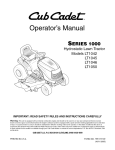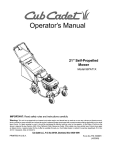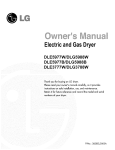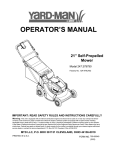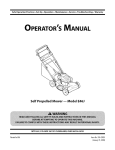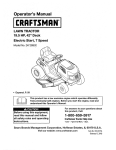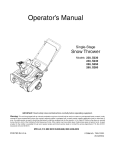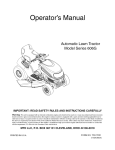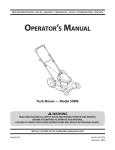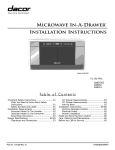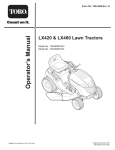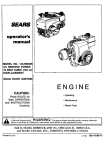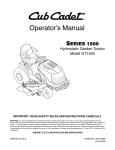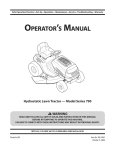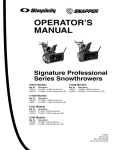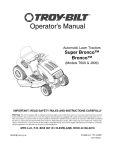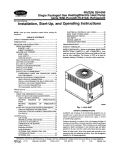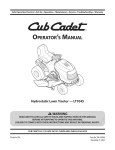Download Cub Cadet LTI050 User's Manual
Transcript
Operator's Manual
SERIES
1000
Hydrostatic Lawn Tractor
Models LT1042
LT1045
LT1046
LTI050
IMPORTANT:
READ SAFETY
RULES AND INSTRUCTIONS
CAREFULLY
Warning:
This unit is equipped with an internal combustion engine and should not be used on or near any unimproved forest-covered,
brush-covered or grass-covered land unless the engine's exhaust system is equipped with a spark arrester meeting applicable local or state laws
(if any), If a spark arrester is used, it should be maintained in effective working order by the operator, In the State of California the above is
required by law (Section 4442 of the California Public Resources Code), Other states may have similar laws, Federal laws apply on federal lands,
A spark arrester for the muffler is available through your Cub Cadet dealer or contact the service department, P,O, Box 361131 Cleveland, Ohio
44136-0019,
CUBCADETLLC, P.O. BOX361131CLEVELAND,OHIO44136-0019
PRINTED IN U.S.A.
FORM
NO. 769-015141'
(1/16/2007)
TABLEOFCONTENTS
Content
Important Safe Operation Practices
Slope Gauge
Tractor Set-up
Know Your Lawn Tractor
Operating Your Lawn Tractor
Making Adjustments
Maintaining Your Lawn Tractor
Service
Page
3
7
8
9
12
17
19
25
Content
Off-season Storage
Maintenance Schedule
Page
30
30
Maintenance Log
Troubleshooting
Attachments & Accessories
31
32
33
Specifications
Replacement Parts
Warranty Information
35
34
37
FINDINGMODELNUMBER
This Operator's Manual is an important part of your new lawn tractor. It will help you assemble, prepare and
maintain the unit for best performance. Please read and understand what it says.
Before you start assembling your new equipment, please locate the model plate on the equipment
and copy the information from it in the space provided below. A sample model plate is also illustrated
below. You can locate the model plate by looking at the underside of the tractor's seat. This information
will be necessary when contacting the Cub Cadet Care Networkor your Cub Cadet dealer.
Copy the model number here:
Copy the serial number here:
Cz bCm Lwww.cubcadet.corn
cub cADETLLO
P. O. 80X 361131
CLEVELAND, OH 44136
_. DEALE R LO£ATO B pHONE NUMSEB!
877:282:8684.)
CUSTOMER
SUPPORT
Please do NOTreturn the unit to the retailer, without first contactingthe CubCadetCare Network.
If you have difficulty assembling this product or have any questions regarding the controls, operation or
maintenance of this unit, you can seek help from the experts. Choose from the options below:
@
Visit www.cubeadet.com
immediately available.
for many useful suggestions. Click on Customer Service and help is
Call the CubCadet Care Networkat (800) 965-4CUB.
SECTION1: IMPORTANT
SAFEOPERATION
PRACTICES
WARNING:
This symbol points out important safety instructions which, if not followed, could endanger
the personal safety and/or property of yourself and others. Read and follow all instructions in this manual
before attempting to operate this machine. Failure to comply with these instructions may result in personal
injury. When you see this symbol--heed its warning.
DANGER:
This machine was built to be operated according to the rules for safe operation in this manual. As with any type of power equipment, carelessness or error on the part of the operator can result in
serious injury. This machine is capable of amputating hands and feet and throwing objects. Failure to
observe the following safety instructions could result in serious injury or death.
California
,_
2.
3.
4.
5.
6.
7.
8.
9.
65 Warning:
or
emit chemicals
to the
Stateof of
cancervehicle
and birth
defects
WARNING:
Engineknown
exhaust,
some
its California
constituents,to cause
and certain
components
reproductive harm.
GENERAL
1.
Proposition
OPERATION
Read, understand, and follow all instructions on the
machine and in the manual(s) before attempting to
assemble and operate. Keep this manual in a safe
place for future and regular reference and for
ordering replacement parts.
Be familiar with all controls and their proper
operation. Know how to stop the machine and
disengage them quickly.
Never allow children under 14 years old to operate
this machine. Children 14 years old and over
should read and understand the operation
instructions and safety rules in this manual and
should be trained and supervised by a parent.
Never allow adults to operate this machine without
proper instruction.
To help avoid blade contact or a thrown object
injury, keep bystanders, helpers, children and pets
at least 75 feet from the machine while it is in
operation. Stop machine if anyone enters the area.
Thoroughly inspect the area where the equipment
is to be used. Remove all stones, sticks, wire,
bones, toys, and other foreign objects which could
be picked up and thrown by the blade(s). Thrown
objects can cause serious personal injury.
Plan your mowing pattern to avoid discharge of
material toward roads, sidewalks, bystanders and
the like. Also, avoid discharging material against a
wall or obstruction which may cause discharged
material to ricochet back toward the operator.
Always wear safety glasses or safety goggles
during operation and while performing an
adjustment or repair to protect your eyes. Thrown
objects which ricochet can cause serious injury to
the eyes.
Wear sturdy, rough-soled work shoes and closefitting slacks and shirts. Loose fitting clothes and
jewelry can be caught in movable parts. Never
operate this machine in bare feet or sandals.
or
other
contain
10. Be aware of the mower and attachment discharge
direction and do not point it at anyone. Do not
operate the mower without the discharge cover or
entire grass catcher in its proper place.
11. Do not put hands or feet near rotating parts or
under the cutting deck. Contact with the blade(s)
can amputate hands and feet.
12. A missing or damaged discharge cover can cause
blade contact or thrown object injuries.
13. Stop the blade(s) when crossing gravel drives,
walks, or roads and while not cutting grass.
14. Watch for traffic when operating near or crossing
roadways. This machine is not intended for use on
any public roadway.
15. Do not operate the machine while under the
influence of alcohol or drugs.
16. Mow only in daylight or good artificial light.
17. Never carry passengers.
18. Disengage blade(s) before shifting into reverse.
Back up slowly. Always look down and behind
before and while backing to avoid a back-over
accident.
19. Slow down before turning. Operate the machine
smoothly. Avoid erratic operation and excessive
speed.
20. Disengage blade(s), set parking brake, stop engine
and wait until the blade(s) come to a complete stop
before removing grass catcher, emptying grass,
unclogging chute, removing any grass or debris, or
making any adjustments.
21. Never leave a running machine unattended. Always
turn off blade(s), place transmission in neutral, set
parking brake, stop engine and remove key before
dismounting.
22. Use extra care when loading or unloading the
machine into a trailer or truck. This unit should not
be driven up or down ramp(s), because the unit
could tip over, causing serious personal injury. The
unit must be pushed manually on ramp(s) to load or
unload properly.
23. Mufflerandenginebecomehotandcancausea
burn.Donottouch.
24. Checkoverhead
clearances
carefullybeforedriving
underlowhangingtreebranches,wires,door
openingsetc.,wheretheoperatormaybestruckor
pulledfromtheunit,whichcouldresultinserious
injury.
25. Disengage
allattachment
clutches,depressthe
brakepedalcompletely
andshiftintoneutralbefore
attempting
to startengine.
26. Yourmachineisdesigned
tocutnormalresidential
grassofa heightnomorethan10".Donotattempt
to mowthroughunusually
tall,drygrass(e.g.,
pasture)orpilesofdryleaves.Drygrassor leaves
maycontacttheengineexhaustand/orbuildupon
themowerdeckpresenting
a potential
fire hazard.
27. Useonlyaccessories
andattachments
approved
forthismachinebythemachinemanufacturer.
Read,understand
andfollowallinstructions
provided
withtheapproved
accessory
or
attachment.
28. Dataindicates
thatoperators,
age60yearsand
above,areinvolvedina largepercentage
ofriding
mower-related
injuries.Theseoperatorsshould
evaluate
theirabilitytooperatetheridingmower
safelyenoughtoprotectthemselves
andothers
fromseriousinjury.
29. If situations
occurwhicharenotcoveredinthis
manual,usecareandgoodjudgment.Contactyour
4.
5.
6.
7.
DO NOT:
1.
2.
3.
4.
5.
6.
Cub Cadet dealer for assistance.
SLOPE OPERATION
7.
Slopes are a major factor related to loss of control and
tip-over accidents which can result in severe injury or
death. All slopes require extra caution. If you cannot
back up the slope or if you feel uneasy on it, do not mow
it.
For your safety, use the slope gauge included as part of
this manual to measure slopes before operating this
unit on a sloped or hilly area. If the slope is greater than
15 degrees as shown on the slope gauge, do not
operate this unit on that area or serious injury could
result.
DO:
1.
2.
3.
Mow up and down slopes, not across. Exercise
extreme caution when changing direction on
slopes.
Watch for holes, ruts, bumps, rocks, or other
hidden objects. Uneven terrain could overturn the
machine. Tall grass can hide obstacles.
Use slow speed. Choose a low enough speed
setting so that you will not have to stop or shift while
on the slope. Tires may lose traction on slopes
even though the brakes are functioning properly.
Always keep machine in gear when going down
slopes to take advantage of engine braking action.
Follow the manufacturer's recommendations for
wheel weights or counterweights to improve
stability.
Use extra care with grass catchers or other
attachments. These can change the stability of the
machine.
Keep all movement on the slopes slow and gradual.
Do not make sudden changes in speed or direction.
Rapid engagement or braking could cause the front
of the machine to lift and rapidly flip over backwards
which could cause serious injury.
Avoid starting or stopping on a slope. If tires lose
traction, disengage the blade(s) and proceed
slowly straight down the slope.
Do not turn on slopes unless necessary; then, turn
slowly and gradually downhill, if possible.
Do not mow near drop-offs, ditches or
embankments. The mower could suddenly turn
over if a wheel is over the edge of a cliff, ditch, or if
an edge caves in.
Do not try to stabilize the machine by putting your
foot on the ground.
Do not use a grass catcher on steep slopes.
Do not mow on wet grass. Reduced traction could
cause sliding.
Do not shift to neutral and coast downhill. Overspeeding may cause the operator to lose control of
the machine resulting in serious injury or death.
Do not tow heavy pull behind attachments (e.g.
loaded dump cart, lawn roller, etc.) on slopes
greater than 5 degrees. When going down hill, the
extra weight tends to push the tractor and may
cause you to loose control. (e.g. tractor may speed
up, braking and steering ability are reduced,
attachment may jack-knife and cause tractor to
overturn).
CHILDREN
,
Tragic accidents can occur if the operator is not
alert to the presence of children. Children are often
attracted to the machine and the mowing activity.
They do not understand the dangers. Never
assume that children will remain where you last
saw them.
a. Keep children out of the mowing area and in
watchful care of a responsible adult other
than the operator.
b. Be alert and turn machine off if a child enters
the area.
c. Before and while backing, look behind and
down for small children.
d. Never carry children, even with the blade(s)
shut off. They may fall off and be seriously
injured or interfere with safe machine
operation.
e. Useextremecarewhenapproaching
blind
corners,doorways,
shrubs,treesor other
objectsthatmayblockyourvisionofa child
whomayrunintothemachine.
f. Toavoidback-overaccidents,always
disengagethecuttingblade(s)before
shiftinginto reverse.The"Reverse
CautionMode" should not be used when
children or others are around.
Keep children away from hot or running
engines. They can suffer burns from a hot
muffler.
h. Remove key when machine is unattended to
prevent unauthorized operation.
Never allow children under 14 years old to operate
the machine. Children 14 years old and over should
read and understand the operation instructions and
safety rules in this manual and should be trained
and supervised by a parent.
g.
,
TOWING
1.
2.
3.
4.
5.
6.
Tow only with a machine that has a hitch designed
for towing. Do not attach towed equipment except
at the hitch point.
Follow the manufacturers recommendation for
weight limits for towed equipment and towing on
slopes.
Never allow children or others in or on towed
equipment.
On slopes, the weight of the towed equipment may
cause loss of traction and loss of control.
Travel slowly and allow extra distance to stop.
Do not shift to neutral and coast downhill.
lock-open device.
Extinguish all cigarettes, cigars, pipes and
other sources of ignition.
f. Neverfuel machine indoors.
g. Never remove gas cap or add fuel while the
engine is hot or running. Allow engine to cool
at least two minutes before refueling.
h. Never over fill fuel tank. Fill tankto no more
than _/2inch below bottom of filler neck to
allow space for fuel expansion.
i.
Replace gasoline cap and tighten securely.
j.
If gasoline is spilled, wipe it off the engine
and equipment. Move unit to another area.
Wait 5 minutes before starting the engine.
k. To reduce fire hazards, keep machine free of
grass, leaves, or other debris build-up. Clean
up oil or fuel spillage and remove any fuel
soaked debris.
I. Never store the machine or fuel container
inside where there is an open flame, spark or
pilot light as on a water heater, space heater,
furnace, clothes dryer or other gas
appliances.
m. Allow a machine to cool at least 5 minutes
before storing.
GENERAL SERVICE:
e.
1.
2.
SERVICE
SAFE HANDLING OF GASOLINE:
,
To avoid personal injury or property damage
use extreme care in handling gasoline. Gasoline is
extremely flammable and the vapors are explosive.
Serious personal injury can occur when gasoline is
spilled on yourself or your clothes which can ignite.
Wash your skin and change clothes immediately.
a. Use only an approved gasoline container.
b. Never fill containers inside a vehicle or on a
c.
d.
truck or trailer bed with a plastic liner. Always
place containers on the ground away from
your vehicle before filling.
When practical, remove gas-powered
equipment from the truck or trailer and refuel
it on the ground. If this is not possible, then
refuel such equipment on a trailer with a
portable container, rather than from a
gasoline dispenser nozzle.
Keep the nozzle in contact with the rim of the
fuel tank or container opening at all times
until fueling is complete. Do not use a nozzle
3.
4.
5.
6.
7.
Never run an engine indoors or in a poorly
ventilated area. Engine exhaust contains carbon
monoxide, an odorless, and deadly gas.
Before cleaning, repairing, or inspecting, make
certain the blade(s) and all moving parts have
stopped. Disconnect the spark plug wire and
ground against the engine to prevent unintended
starting.
Periodically check to make sure the blades come to
complete stop within approximately (5) five
seconds after operating the blade disengagement
control. If the blades do not stop within the this time
frame, your unit should be serviced professionally
by your Cub Cadet dealer.
Check brake operation frequently as it is subjected
to wear during normal operation. Adjust and service
as required.
Check the blade(s) and engine mounting bolts at
frequent intervals for proper tightness. Also,
visually inspect blade(s) for damage (e.g.,
excessive wear, bent, cracked).
Replace the blade(s) with the original equipment
manufacturer's (O.E.M.) blade(s) only, listed in this
manual. "Use of parts which do not meet the
original equipment specifications may lead to
improper performance and compromise safety!"
Mower blades are sharp. Wrap the blade or wear
gloves, and use extra caution when servicing them.
Keep all nuts, bolts, and screws tight to be sure the
equipment is in safe working condition.
8. Nevertamperwiththesafetyinterlocksystemorother
safetydevices.Checktheirproperoperationregularly.
9. Afterstrikinga foreignobject,stoptheengine,
disconnect
thesparkplugwire(s)andgroundagainst
theengine.Thoroughly
inspectthemachine
forany
damage.Repairthedamagebeforestartingand
operating.
10. Neverattemptto makeadjustments
or repairstothe
machinewhiletheengineisrunning.
11. Grasscatchercomponents
andthedischarge
coverare
subjecttowearanddamagewhichcouldexpose
movingpartsorallowobjectstobethrown.
_,
Forsafetyprotection,
frequentlycheckcomponents
and
replaceimmediately
withoriginalequipment
manufacturer's
(O.E.M.)
partsonly,listedinthis
manual."Useofpartswhichdonotmeettheoriginal
equipment
specifications
mayleadto improper
performance
andcompromise
safety!"
12. Donotchangetheenginegovernorsettingsoroverspeedtheengine.Thegovernorcontrolsthemaximum
safeoperating
speedoftheengine.
13. Maintainorreplacesafetyandinstruction
labels,as
necessary.
14. Observeproperdisposallawsandregulations
forgas,
oil,etc.toprotecttheenvironment.
andfollowthewarnings
andinstructions
inthismanual
andonthemachine.
ARNING: YOURRESPONSIBILITY
Restricttheuseofthispower
machine
topersonswhoread,understand
ROTATING
BLADES CAUSE
SER|OLJS iNJURY OR DEATH
• DONOTMOWWHENCHILDREN
0ROTHERS
ARE
AROUND
• HEVER
CARRY
CHILDREN
EVEN
WiTHBLADE{S)
OFF.
• LOOKDOWHAHDBEHIHD
BEFORE
AHDWHILE
BACKIHO.
• MOWiHO
IH REVERSE
iSHOTHECOMMEHDED.
$30503
ASSEMBLECHUTE DEFLECTORTO THiS UNiT BEFOREOPERATJHG,
®
Sight and hold this levelwith a vertical tree...
or a corner of a building...
i _------
or a fence post
|
Sonts
a 15o
!
I.IJ
I.IJ
Q.
15°
&i
Z
I.IJ
SECTION3: TRACTOR
SET-UP
ShippingBraceRemoval
AttachingtheBatteryCables
NOTE:
_,
engine
is off, Make
set the
brake
and
WARNING:
sure parking
the riding
mower's
remove the ignition key before removing the
shipping brace.
Locate the shipping brace, if present, and warning
tag found on the right side of the cutting deck.
While holding the discharge chute with your left
hand, remove the shipping brace with your right
hand by grasping it between your thumb and index
finger and rotating it clockwise.
WARNING:
The shipping brace, used for
packaging purposes only, must be removed
and discarded before operating your riding
mower.
WARNING:
The mowing deck is capable of
throwing objects. Failure to operate the riding
mower without the discharge cover in the
proper operating position could result in
serious personal
injury and/or property
damage.
Tire Pressure
_,
any
circumstances
is 30
Equalunder
tire
WARNING:
Maximum
tire psi.
pressure
pressure should be maintained at all times.
The tires on your unit may be over-inflated for shipping
purposes. Reduce the tire pressure before operating
the tractor. Recommended operating tire pressure is
approximately 10 p.s.i for the rear tires & 14 p.s.i, for
the front tires. Check sidewall of tire for maximum p.s.i.
The positive battery terminal is marked Pos.
(+). The negative battery terminal is marked Neg. (-).
•
The positive cable (heavy red wire) is secured to
the positive battery terminal (+) with a hex bolt and
hex nut at the factory. Make certain that the red
rubber boot covers the terminal to help protect it
from corrosion.
•
Remove the carriage bolt and hex nut from the
negative cable.
Remove the black plastic cover, if present, from the
negative battery terminal and attach the negative
cable (heavy black wire) to the negative battery
terminal (-) with the bolt and hex nut.
Make certain the hold-down rod is in position over
the battery, securing it in place.
•
•
NOTE:
If the battery is put into service after the date
shown on top/side of battery, charge the battery as
instructed on page 26 of this manual prior to operating
the tractor.
GasandOilFill-up
The gasoline tank is located under the fender and has a
capacity of three and-a-half gallons. Remove the fuel
cap by turning it counterclockwise. Use only clean,
fresh (no more than 30 days old), unleaded gasoline.
Fill the tank no higher than four inches below the top of
the filler neck to allow space for fuel expansion.
WARNING:
Use
extreme
care
when
handling gasoline. Gasoline is extremely
flammable and the vapors are explosive.
Never fuel machine indoors or while the
engine
is hot or running.
Extinguish
cigarettes, cigars, pipes, and other sources of
ignition.
IMPORTANT: Your tractor is shipped with oil in the
engine. However, you MUST check the oil level before
operating. Refer to Checking
the 0il Levelon page 19 for
detailed instructions. Be careful not to overfill.
SECTION4: KNOWYOURLAWNTRACTOR
A
B
C
H
J
D
F
NOTE:
Steering Wheel not shown for clarity,
Figure I
A Systems Indicator Monitor/Hour Meter
B Throttle Control Lever
H PTO (Blade Engage) Knob
I Brake Pedal
C Choke Control
J
D Parking Brake Lever
K Cruise Control Lever
E FueITank Cap
L Deck Lift Lever
F Seat Adjustment Lever
M Cup Holder
Drive Pedal
G Ignition Switch Module
NOTE: Any reference in this manual to the RIGHT or LEFT side of the tractor is observed from operator's position.
ThrottleControlLever
The throttle control lever is
located on the left side of the
IgnitionSwitchModule
Fast
Position
WARNING:
Never leave a running machine
unattended. Always disengage PTO, move
shift lever into neutral position, set parking
brake, stop engine and remove key to prevent
unintended starting.
tractor's dash panel. This lever
controls the speed of the engine.
When set in a given position, the
throttle will maintain a uniform
engine speed.
IMPORTANT:When operating the
tractor with the cutting deck
engaged, be certain that the
throttle lever is always in the
FAST (rabbit) position.
To start the engine, insert the key into the ignition
switch and turn clockwise to the START position.
Release the key into the NORMAL MOWING MODE
position once the engine has fired.
To stop the engine, turn the ignition key
counterclockwise to the STOP position. See Figure 2.
SI0w
Position
ChokeControl
The choke control can be found
Normal
Mowing Mode
on the left side of the dash panel
and is activated by pulling the
knob outward. Activating the
choke control closes the choke
Stop
Position
plate on the carburetor and aids
in starting the engine. Refer to
StartingThe Engineon page 13 of
this manual for detailed starting
instructions.
Start
Position
BrakePedal
The brake pedal is located on the
right front side of the tractor
above the drive pedal along the
running board. The brake pedal
can be used for sudden stops or
setting the parking brake.
(o)
NOTE:
The brake pedal must
be fully depressed to activate the
safety interlock
switch
when
starting the tractor.
Figure 2
IMPORTANT: Prior to operating the tractor, refer to both
SafetyInterlock Switcheson page 12 and StartingTheEngine
on page 13 of this manual for detailed instructions
regarding the Ignition Switch Module and operating the
tractor in REVERSE CAUTION MODE.
DrivePedal
The drive pedal is located on the
right side of the tractor, along the
running board. Press the upper
portion of the drive pedal forward
to cause the tractor to travel
forward. Press the lower portion
of the drive pedal with the ball of
your right foot (NOT your heel) to
cause the tractor to travel in
reverse. Ground speed is also
controlled with the drive pedal.
The further forward or rearward
that the pedal is pivoted, the
faster the tractor will travel. The
pedal will return to its original
position when it's not pressed.
SeatAdjustmentLever
To adjust the seat forward or backward, slide the seat
adjustment lever to the left and reposition the seat to
the desired position. Once a comfortable position is
found, release the seat adjustment lever to lock the seat
in place. Refer to SeatAdjustment
on page 18 of this
manual for more detailed instructions.
DeckLiftLever
Found on your tractor's right fender, the deck lift lever is
used to change the height of the cutting deck. To use,
move the lever to the left, then place in the notch best
suited for your application.
IMPORTANT: Always set the
parking brake when leaving the
tractor unattended.
10
SystemsIndicatorMonitor/ HourMeter
BATT.
OIL
ElectricPTO/
BladeEngageKnob
|
To engage the power to the
cutting deck or other (separately
available) attachments, pull
outward on the PTO/Blade
.J
......J
qlL
II
Engage knob. Push the PTO/
Blade Engage knob inward to
disengage the power to the
cutting deck or other (separately available)
attachments.
42.0
///
j
HOURS
1/10 \\\
/
jr
11
NOTE:
PTO / BLADE
The PTO/Blade Engage knob must be in the
disengaged (OFF) position when starting the engine.
PARKING
CruiseControl
Lever
LCD
The cruise control
lever is located on
the tractor dash
Located in the center of the tractor's console, the
systems indicator monitor records, and displays on its
LCD, hours of tractor operation whenever the ignition
key is rotated out of the STOP position.
panel, below the steering wheel. Push the cruise
control lever downward while traveling forward at a
desired speed. While holding the lever down, release
pressure from the drive pedal.
This will engage the cruise control and allow the tractor
to remain at that speed without applying pressure to the
drive pedal. Press the brake pedal or the drive pedal to
deactivate cruise control. Refer to page 14 for detailed
instructions regarding the cruise control feature.
The Indicator Monitor will also remind the operator of
maintenance intervals for changing the engine oil. The
LCD will alternately flash the recorded hours, "CHG"
and "OIL" for five minutes, after every 50 hours of
recorded operation elapse. The maintenance interval
lasts for two hours (from 50-52, 100-102, 150-152,
etc.). The LCD will also flash as described above for
five minutes every time the tractor's engine has been
started during this maintenance interval. Before the
interval expires, change the crankcase oil level as
instructed in this Operator's Manual.
NOTE:
Cruise control can NOT be engaged at the
tractor's fastest ground speed. If the operator should
attempt to do so, the tractor will automatically
decelerate to the fastest optimal mowing ground speed.
Brake
If the Brake light illuminates when attempting to start
the tractor's engine, depress the brake pedal.
Parking Brake
Lever
PTO(Blade Engage)
If the PTO light illuminates when attempting to start the
tractor's engine, move PTO lever into the disengaged
(OFF) position.
To set the parking
brake, fully depress
the brake pedal and
push the parking brake lever down. Hold the lever down
while taking your foot off the brake pedal. Both the
parking lever and the brake pedal will then stay
depressed. To release the parking brake, depress the
brake pedal slightly. The parking brake lever will then
return to its original position.
0il
It is normal for the Oil light to illuminate while the engine
is cranking during start-up, but if it illuminate's during
operation, while the engine is running, stop the
tractor immediately and check the engine oil level as
instructed in this Owner's Manual.
NOTE:
The parking brake must be set if the operator
leaves the seat with the engine running or the engine
will automatically shut off.
Battery
It is normal for the Battery light to illuminate while the
engine is cranking during start-up, but if it illuminate's
during operation, while the engine is running, the
battery is in need of a charge or the engine's charging
system is not generating sufficient amperage. Charge
the battery as instructed on page 26 of this manual or
have the charging system checked by your Cub Cadet
dealer.
IMPORTANT: Always set the parking brake when
leaving the tractor unattended.
11
SECTION5: OPERATING
YOURLAWNTRACTOR
WARNING:
AVOIDSERIOUS
INJURYORDEATH
•
•
•
•
•
•
•
•
GO UP AND DOWN SLOPES, NOT ACROSS.
AVOID SUDDEN TURNS.
DO NOT OPERATE THE UNIT WHERE IT COULD SLIP OR TIR
IF MACHINE STOPS GOING UPHILL, STOP BLADE(S) AND BACK
DOWNHILL SLOWLY.
DO NOT MOW WHEN CHILDREN OR OTHERS ARE AROUND.
NEVER CARRY CHILDREN, EVEN WITH BLADES OFR
LOOK DOWN AND BEHIND BEFORE AND WHILE BACKING.
KEEP SAFETY DEVICES (GUARDS, SHIELDS, AND SWITCHES) IN
PLACE AND WORKING.
REMOVE OBJECTS THAT COULD BE THROWN BY THE BLADE(S).
KNOW LOCATION AND FUNCTION OF ALL CONTROLS.
BE SURE BLADE(S) AND ENGINE ARE STOPPED BEFORE PLACING HANDS OR FEET NEAR BLADE(S).
BEFORE
LEAVING
OPERATOR'S
POSITION,
DISENGAGE
BLADE(S),
PLACE THE SHIFT LEVER IN NEUTRAL,
ENGAGE
BRAKE LOCK, SHUT ENGINE OFF AND REMOVE KEY.
IMPORTANT:The operator MUST be seated in the
tractor seat.
1.
2.
3.
SafetyInterlockSwitches
This tractor is equipped with a safety interlock system
for the protection of the operator. If the interlock system
should ever malfunction, do not operate the tractor.
Contact your Cub Cadet dealer.
•
•
•
_,
4.
The safety interlock system prevents the engine
from cranking or starting unless the parking brake is
engaged, and the PTO (Blade Engage) knob is in
the disengaged (OFF) position.
The engine will automatically shut off if the operator
leaves the seat before engaging the parking brake.
The electric PTO (Blade Engage) clutch will
automatically shut off if the operator leaves the
tractor's seat with the PTO (Blade Engage) knob in
the engaged (ON) position, regardless of whether
the parking brake is engaged.
With the ignition key in the NORMAL MOWING
position, the electric PTO (Blade Engage) clutch
will automatically shut off if the PTO (Blade
Engage) knob is moved into the engaged (ON)
position with the drive pedal in position for Reverse
travel.
5.
6.
Start the engine as previously instructed in this
Operator's Manual.
Turn the key from the NORMAL MOWING
(Green) position to the REVERSE CAUTION
MODE (Yellow) position of the key switch module.
See Figure 3.
Depress the REVERSE PUSH BUTTON (Orange,
Triangular Button) at the top, right corner of the key
switch module. The red indicator light at the top, left
corner of the key switch module will be ON while
activated. See Figure 3.
Once activated (indicator light ON), the tractor can
be driven in reverse with the cutting blades (PTO)
engaged.
Always look down and behind before and while
backing to make sure no children are around.
After resuming forward motion, return the key to the
NORMAL MOWING position.
IMPORTANT: The REVERSE CAUTION MODE will
remain activated until:
a.
b.
The key is placed in either the NORMAL
MOWING position or STOP position.
The operator leaves the seat.
NO
Indicator
Light
CHILDREN
A_OU_ID
Reverse
Push Button
BUTTON
REVERSE PUSH
Reverse
- Caution Mode
Position
Stop
Position
interlock
system
is operate
malfunctioning.
ARNING:
Do not
the tractor ifThis
the
system was designed for your safety and
protection.
Start
Position
ReverseCautionMode
The REVERSE CAUTION MODE position of the key
switch module allows the tractor to be operated in
reverse with the blades (PTO) engaged.
IMPORTANT:
while
To use the REVERSE CAUTION MODE:
READOPERATOR'S
MANUAL
•
caution
operating the tractor in the REVERSE
CAUTION MODE. Always look down and
behind before and while backing. Do not
operate the tractor when children or others
are around. Stop the tractor immediately if
someone enters the area.
WARNING
•
•
•
•
Use extreme
Mowing in reverse is not recommended.
Figure 3
12
•
If the gauge wheels have excessive clearance with
the surface below, lower the wheels to the index
hole that provides the approximate 1/2" clearance
as described above.
Refer to Levelingthe Deckon page 17 of this manual for
more detailed instructions regarding various deck
adjustments.
SettingtheGaugeWheels
Select the height position of the cutting deck by placing
the deck lift lever in any of the six different cutting height
notches on the right fender.
Adjust the deck wheels so that they are between l_-inch
and _/2-inchabove the ground as follows.
Startingthe Engine
from
the discharge
of the
WARNING:
Keep opening
hands and
feet cutting
away
deck.
Place the tractor on a firm and level surface, preferably
pavement. Refer to Figure 4, and proceed as follows:
•
interlock system
is operate
malfunctioning.
WARNING:
Do not
the tractor ifThis
the
system was designed for your safety and
protection.
Place the tractor's deck lift handle in the normally
desired mowing height setting, then check the
gauge wheels for contact or excessive clearance
with the surface below.
NOTE:
Refer to the TRACTOR
SET-UPon page 8 of this
manual for Gasoline and Oil fill-up instructions.
ShoulderScrew
\
•
Insert the tractor key into the ignition switch
module.
•
Place the PTO (Blade Engage) knob in the
disengaged (OFF) position.
Engage the tractor's parking brake.
Activate the choke control.
•
•
•
Lock Nut
ShoulderScrew
0
Turn the ignition key clockwise to the START
position. After the engine starts, release the key. It
will return to the NORMAL MOWING position.
IMPORTANT: Do NOT hold the key in the START
position for longer than ten seconds at a time. Doing so
may cause damage to your engine's electric starter.
,ocelot
\
•
After the engine starts, deactivate the choke
control.
NOTE:
Figure 4
If the wheels contact the surface adjust as follows:
a.
Raise the deck lift handle to its highest
setting.
b. Remove the rear gauge wheels by removing
the lock nuts and shoulder screws which
secure them to the deck.
c. Remove the lock nuts and shoulder screws
d.
e.
f.
Do NOT leave the choke control on while
operating the tractor. Doing so will result in a "rich" fuel
mixture and cause the engine to run poorly.
Stoppingthe Engine
WARNING:
If you strike a foreign object,
stop the engine and disconnect the spark plug
wire(s). Thoroughly inspect the machine for
any damage. Repair the damage before
restarting and operating
which secure the front gauge wheels to the
deck.
Place the deck lift handle in the desired
•
mowing height setting.
Insert the shoulder screw with the rear gauge
wheel into the index hole that leaves
•
•
approximately 1/2" between the bottom of
the wheel and the pavement.
Note the position of the index hole used; then
install the other rear gauge wheel and the
front ball wheels into the corresponding index
hole of the other gauge wheel brackets.
•
13
If the blades are engaged, place the PTO/Blade
Engage knob in the disengaged (OFF) position.
Place the throttle control near the FAST position
Turn the ignition key counterclockwise to the STOP
position.
Remove the key from the ignition switch to prevent
unintended starting.
•
EngagingtheParkingBrake
To engage the parking brake:
•
Fully depress the brake pedal and hold it while
gently pushing the parking brake lever downward.
•
Hold the parking brake lever down while removing
your foot from the brake pedal.
•
Once engaged, the parking brake lever and the
brake pedal will lock in the "down" position.
To disengage the parking brake:
•
To travel in REVERSE, check that the area behind
is clear then slowly depress the lower portion of the
drive pedal with the ball of your foot (NOT your
heel) until the desired speed is achieved. See
Figure 5.
IMPORTANT: Do NOT attempt to change the direction of
travel when the tractor is in motion. Always bring the
tractor to a complete stop before pivoting the drive
pedal from forward to reverse or vice versa.
Slightly depress the brake pedal.
DrivingOnSlopes
NOTE:
The parking brake must be engaged if the
operator leaves the seat with the engine running or the
engine will automatically shut off.
Refer to the SLOPEGAUGEon page 7 to help determine
slopes where you may operate the tractor safely.
DrivingTheTractor
_,
cessive
speed and
sudden
stops. starts,
WARNING:
Avoid
sudden
injury.
ex•
•
_,
•
•
slope
in excess
degrees
(a rise
ARNING:
Do of
not 15
mow
on inclines
with of
a
approximately 2-1/2 feet every 10 feet). The
tractor could overturn and cause serious
tractor
without Do
firstnot
placing
PTO/Blade
WARNING:
leave the
the seat
of the
Engage knob in the disengaged
(OFF)
position, pressing the brake pedal and
engaging the parking brake. If leaving the
tractor unattended, also turn the ignition key
off and remove the key.
•
•
Briefly depress the brake pedal to release the
parking brake. Move the throttle lever into the FAST
(rabbit) position.
To travel FORWARD, slowly depress the upper
portion of the drive pedal forward until the desired
speed is achieved. See Figure 5.
•
Mow up and down slopes, NEVER across.
Exercise extreme caution when changing direction
on slopes.
Watch for holes, ruts, bumps, rocks, or other
hidden objects. Uneven terrain could overturn the
machine. Tall grass can hide obstacles.
Avoid turns when driving on a slope. If a turn must
be made, turn down the slope. Turning up a slope
greatly increases the chance of a roll over.
Avoid stopping when driving up a slope. If it is
necessary to stop while driving up a slope, start up
smoothly and carefully to reduce the possibility of
flipping the tractor over backward.
SettingTheCruiseControl
Brake Pedal
NOTE:
The cruise control feature should only be
utilized while traveling in the forward direction,
•
•
•
•
Drive Pedal
Slowly press the upper portion of the drive pedal
until the desired speed is achieved.
Lightly press the cruise control lever.
While continuing to hold the cruise lever down, lift
your foot from the drive pedal (you should feel the
cruise latch engage).
Once engaged, the cruise control lever and the
drive pedal will lock in the "down" position, and the
tractor will maintain the same forward speed.
NOTE:
Cruise control can not be set at the tractor's
fastest ground speed. If the operator should attempt to
do so, the tractor will automatically decelerate to the
fastest optimal mowing ground speed.
Figure 5
14
Disengage the cruise control using one of the following
methods:
•
•
IMPORTANT:Never attempt to move the tractor
manually without first opening the hydrostatic relief
valve. Doing so will result in serious damage to the
tractor's transmission.
Depress the brake pedal to disengage the cruise
control and stop the tractor.
Lightly depress the drive pedal.
Engagingthe PTO
To change the direction of travel to reverse when
operating with cruise control, depress the brake pedal
to disengage the cruise control and bring the tractor to a
complete stop. Then slowly depress the rear portion of
the drive pedal with the ball of your foot to travel in
reverse.
Engaging the PTO transfers power to the cutting deck
or other (separately available) attachments. To engage
the PTO, proceed as follows:
•
•
UsingtheDeckLiftLever
•
To raise the cutting deck, move the deck lift lever to the
left, then place it in the notch best suited for your
application. Refer to SettingThe CuttingHeight earlier in
this section.
Move the throttle control lever to the FAST (rabbit)
position.
Pull the PTO/Blade Engage knob outward intothe
engaged (ON) position. See Figure 7.
Keep the throttle lever in the FAST (rabbit) position
for the most efficient use of the cutting deck or other
(separately available) attachments.
IMPORTANT:The electric PTO clutch will automatically
shut off ifthe PTO is engaged with the drive pedal in
position for reverse travel. Refer to SafetyInterlock
Switcheson page 12.
OperatingtheHeadlights
The lamps are ON whenever the ignition key is moved
out of the STOP position. The lamps turn OFF when the
ignition key is moved to the STOP position.
Front View
Top View
MovingTheTractorManually
Your tractor's transmission is equipped with a
hydrostatic relief valve for occasions when it is
necessary to move the tractor manually. Opening this
valve permits the fluid in the transmission to bypass its
normal route, allowing the rear tires to "freewheel." To
open the hydrostatic relief valve, proceed as follows:
•
!
Locate the hydrostatic bypass rod in the rear of the
tractor. See Figure 6.
1
Figure 7
Mowing
WARNING:
To help avoid blade contact or
a thrown object injury, keep bystanders,
helpers, children and pets at least 75 feet
from the machine while it is in operation. Stop
machine if anyone enters the area.
The following information will be helpful when using the
cutting deck with your tractor.
WARNING:
Plan your mowing pattern to
avoid discharge of materials toward roads,
sidewalks, bystanders and the like. Also,
avoid discharging material against a wall or
obstruction which may cause discharged
material to ricochet back toward the operator.
Hydrostatic
BypassRod
Figure 6
•
•
Pull the hydrostatic bypass rod outward, then
down, to lock it in place.
•
NOTE:
The transmission will NOT engage when the
hydrostatic bypass rod is pulled out. Return the rod to
its normal position prior to operating the tractor.
•
15
Do not mow at high ground speed, especially if a
mulch kit or grass collector is installed.
Do not cut the grass too short. Short grass invites
weed growth and yellows quickly in dry weather.
Mowing should always be done with the engine at
full throttle.
•
•
•
•
For best results it is recommended that the first two
laps be cut with the discharge thrown towards the
center. After the first two laps, reverse the direction
to throw the discharge to the outside for the
balance of cutting. This will give a better
appearance to the lawn.
Under heavy conditions it may be necessary to go
over the cut area a second time to get a clean cut.
Do NOT attempt to mow heavy brush and weeds or
extremely tall grass. Your tractor is designed to
mow lawns, NOT clear brush.
Keep the blades sharp and replace the blades
when worn. Refer to CuttingBladeson page 25 of this
manual for proper blade sharpening instructions.
Carriage Screw
@
Mulching
Plastic Wing Nut
NOTE:42-inch Deck Shown.
Cub Cadet Series 1000 tractors are equipped with a
mulch kit which incorporates special blades, already
standard on your tractor, in a process of recirculating
grass clippings repeatedly beneath the cutting deck.
The ultra-fine clippings are then forced back into the
lawn where they act as a natural fertilizer. Observe the
following points for the best results when mulching.
•
•
•
•
Figure 8
50-inch Decks
On model LTI050, the mulch kit is installed at the
factory. To operate the cutting deck without mulching,
simply remove the mulch plug by pivoting the discharge
chute up and pulling the plug outward. To reinstall plug:
Never attempt to mulch if the lawn is damp. Wet
grass tends to stick to the underside of the cutting
deck preventing proper mulching of the clippings.
Do NOT attempt to mulch more than 1/3 the total
height of the grass or approximately 1-1/2 inches.
Doing so will cause the clippings to clump up
beneath the deck and not be mulched effectively.
Maintain a slow ground speed to allow the grass
clippings more time to effectively be mulched.
Always keep the throttle control lever in the FAST
(rabbit) position while mowing. Failing to keep the
engine at full throttle places strain on the tractor's
engine and does not allow the blades to properly
mulch grass.
Locate two rectangular holes on the cutting deck
surface.
•
•
•
Pivot the discharge chute up to access the deck
opening. See Figure 9.
Insert the mulch plug, aligning the top edge of the
plug with the deck as shown in the Figure 9. Make
sure the notches on the plug are in the slots on the
deck opening.
Lightly tap on the plug with your hand to assure that
the notches fit snugly under the chute tabs.
NOTE:
It is not necessary to remove the discharge
chute to operate the mower with the mulch kit installed.
_,
Mulch Plug
mulch
plug whileNever
the engine
running.
ARNING:
installis or
remove the
42- and 46-inch Becks
On model LT1042, LT1045 and LT1046 the mulch kit is
installed at the factory. To operate the cutting deck
without mulching, simply remove the mulch plug by
unthreading the plastic wing nut which fastens it to the
cutting deck. This will allow the clippings to discharge
out the side. See Figure 8.
Mulch Plug
Figure 9
16
SECTION6: MAKINGADJUSTMENTS
•
WARNING:
Shut the engine off, remove
the ignition key and engage the parking brake
before making adjustments.
Protect your
hands by using heavy gloves when handling
the blades.
•
Tighten the inner hex nuts front against the front
hanger bracket to raise the front of the deck; loosen
the hex nuts to lower the front of the deck. See
Figure 10.
Retighten the two lock nuts against the inner hex
nuts when proper adjustment is achieved.
Levelingthe Deck
Sideto Side
NOTE:
If the cutting deck appears to be mowing unevenly, a
side to side adjustment can be performed. Adjust if
necessary as follows:
Check the tractor's tire pressure before
performing any deck leveling adjustments. Refer to
Tires on page 25 for information regarding tire pressure.
•
Front To Rear
The front of the cutting deck is supported by a stabilizer
bar that can be adjusted to level the deck from front to
rear. The front of the deck should be between 1/4-inch
•
and 3/8-inch lower than the rear of the deck. Adjust if
necessary as follows:
•
•
•
•
•
•
Park the tractor parked on a firm, level surface and
place the deck lift lever in the top notch.
Rotate the blade nearest the discharge chute so
that it is parallel with the tractor.
Measure the distance from the front of the blade tip
to the ground and the rear of the blade tip to the
ground.
The first measurement taken should be between
1/4" and 3/8" less than the second measurement.
Determine the approximate distance necessary for
proper adjustment and proceed, if necessary.
From the front of the tractor, loosen the hex lock nut
on each end of the deck hanger rod, and turn away
from the inner hex nuts. See Figure 10
•
With the tractor parked on a firm, level surface,
place the deck lift lever in the top notch (highest
position) and rotate both blades so that they are
perpendicular with the tractor.
Measure the distance from the outside of the left
blade tip to the ground and the distance from the
outside of the right blade tip to the ground. Both
measurements taken should be equal. If they're
not, proceed to the next step.
Loosen, but do NOT remove, the hex bolt on the left
deck hanger bracket. See Figure 11.
NOTE:
Some models have an extruded hanger
bracket with a pivot cup, and only one hex nut and lock
nut. Adjust using the same procedure.
DeckHangerRod
_f--LockNut
........................
_-_I.........
,f£[[[e",
Figure 11
%
•
•
HexNut
•
/
Figure 10
17
Raise and lower the left side of the deck by using a
wrench to turn the adjustment gear. See Figure 11.
The deck is properly leveled when both blade tip
measurements taken earlier are equal.
Retighten the hex bolt on the left deck hanger
bracket when proper adjustment is achieved.
ParkingBrakeAdjustment
If the tractor does not come to a complete stop when
the brake pedal is completely depressed, or if the
tractor's rear wheels can roll with the parking brake
applied (and the hydrostatic relief valve open), the
brake is in need of adjustment. See your Cub Cadet
dealer to have the brake properly adjusted.
SeatAdjustment
WARNING:
Before operating the tractor,
make sure the seat is engaged in the seat
stop, stand behind the machine and pull back
on seat until fully engaged into stop.
To adjust the position of the seat forward or backward,
move the seat adjustment lever to the left and slide the
seat forward or rearward. Make sure seat is locked into
Figure 12
position before operating the tractor.
NOTE:
Threading the ball joints too far onto the drag
finks will cause the front tires to "toe-in" too far. Proper
toe-in is between 1/16" and 5/16".
SteeringAdjustment
If the tractor turns tighter in one direction than the other,
or if the ball joints are being replaced due to damage or
wear, the steering drag links may need to be adjusted.
Front tire toe-in can be measured as follows:
•
Adjust the drag links so that equal lengths are threaded
into the ball joint on the left side and the ball joint on the
right side:
•
•
•
•
•
Loosen the jam nut found on the drag link at the
rear of the ball joint. See Figure 12.
Remove the hex nut on the top of ball joint.
Thread the ball joint toward the jam nut to shorten
the drag link. Thread the ball joint away from the
jam nut to lengthen the drag link.
Replace the hex nut and retighten the jam nut after
proper adjustment is achieved.
•
•
•
18
Place the steering wheel in position for straight
ahead travel.
In front of the axle, measure the distance
horizontally from the inside of the left rim to the
inside of the right rim. Note the distance.
Behind the axle, measure the distance horizontally
from the inside of the left rim to the inside of the
right rim. Note the distance.
The measurement taken in front of the axle should
be between 1/16" and 5/16" less than the
measurement taken behind the axle.
Adjust if necessary.
SECTION7: MAINTAININGYOURLAWNTRACTOR
NOTE:
Refer to MaintenanceCharton page 30 for a
reference of recommended maintenance intervals.
TEMPERATURE/ OiL ViSCOSiTYCHART
**
WARNING:
Before
performing
any
maintenance or repairs, disengage PTO, set
parking brake, stop engine and remove key to
prevent unintended starting.
Engine
oF_io i
Maintenance, repair, or replacement of the emission
control devices and systems, which are being done at
the customer's expense, may be performed by any
engine repair establishment or individual. Warranty
repairs must be performed by a Cub Cadet Dealer.
°0130
*Use of syntheticoil having5W-20or 5W-30rating is acceptaNe,
upto 4°C(40%),
**Synthetic oils will providebetterstarting in extremecold below
23°C(-10%),
EngineOil Recommendations
Using the proper type and weight of engine oil is
extremely important, as is checking and changing oil
regularly. Failure to use the correct oil, or operating the
engine with dirty oil will result in premature engine wear
and failure.
the engine with the oil level
outside of the Operating
Range on the dipstick.
After checking the oil
level (and adding oil, if
necessary), reinstall the
oil fill cap/dipstick onto
the oil fill tube.
Remove the oil fill cap/dipstick by lifting it (single
cylinder models) or twisting it (twin cylinder models)
out of the oil fill tube.
•
•
•
•
•
Allow the engine a few minutes to rest after operation. This will give the oil time to drain into the crankcase sump and result in a more accurate dipstick
reading.
•
o,o 8,'0 loo
1'0
2:0
3:0
40
OperatingRange
Adding Oil
If, after checking the oil level,
you find the dipstick reads L,
proceed as follows.
Checkingthe 0il Level
It is important to check the oil level at least every four
hours of operation. Regular checking during the first 24
hours of operation is especially important. Check the oil
level before each use as follows:
Clean the area around the oil fill cap/dipstick to prevent debris from entering the crankcase.
0
IMPORTANT: Never operate
anticipated temperatures prior to
the next scheduled oil change.
Refer to the Temperature / Oil Viscosity Chart.
•
2:0324i
-£0
Temperature Change Expected Before Next Oil Change
EngineOil Type
Use only a high quality detergent
oil of API (American Petroleum
Institute) service class SG, SH,
SJ or higher. Selection of engine
oil should be based on the lowest
•
-i0
•
Place the tractor on a level surface. Engage the
parking brake, stop the engine and remove the key.
Clean the area around the oil fill cap and fill tube to
prevent debris from entering the crankcase.
Remove the oil fill cap/dipstick from the oil fill tube
and SLOWLY pour oil into the oil fill tube. Do NOT
pour more than 6 oz. of oil at a time without first
stopping and re-checking the oil level.
Fill the crankcase until the oil level reaches the full
(F) mark on the dipstick. See Figure above. Refer to
the viscosity oil chart for information regarding the
proper type of oil to add to the crankcase.
IMPORTANT:The engine may overheat and/or damage
may result if the oil level is below the L or above the F
on the dipstick.
Wipe the dipstick clean before pushing it all the way
back into the oil fill tube. Withdraw the dipstick to
check the oil level. Refer to figure at right.
•
Always keep the oil level at or near the FULL mark
on the dipstick. If the oil is low, add oil of the proper
type up to the FULL mark. Always re-check the oil
level with the dipstick before adding more oil.
Reinstall the oil fill cap/dipstick securely onto the oil
fill tube.
IMPORTANT:The oil fill cap/dipstick must be installed
securely onto the tube at all times when the engine
is operating. Severe engine damage could result from
failure to do so.
19
ChangingtheEngine011
Oil Fill Oap/ Dipstick
The engine oil and oil filter should be changed after
every 50 hours of tractor operation.
WARNING:
If the engine has been recently
run, the engine, muffler and surrounding
metal surfaces will be hot and can cause
burns to the skin. Allow the tractor to cool and
use caution when removing
IMPORTANT:The oil filter should be changed at every
oil change interval.
To complete an oil change, proceed as follows:
Braining the Oil
Run the engine for a few minutes to allow the oil in the
crankcase to warm up. Warm oil will flow more freely
and carry away more of the engine sediment which may
have settled at the bottom of the crankcase. Use care to
avoid burns from hot oil.
•
•
•
•
Oil Filter
/
Oil FillOap/ Dipstick
\
Pop open the protective cap on the end of the oil
drain valve to expose the drain port. See Figure 13.
Remove the oil fill cap/dipstick from the oil fill tube.
Push the oil drain hose (packed with this manual)
onto the oil drain port. Route the opposite end of
the hose into an appropriate oil collection container
with at least a 2.5 quart capacity, to collect the used
oil.
Push the oil drain valve in slightly, then rotate
counterclockwise and pull outward to begin
draining oil.
NOTE:
Oil Drain Hose
Kohler Courage7MSingle
The oil drain valve is found on the left-hand
side of single cylinder engines and the right-hand side
of twin-cylinder engines.
Figure 13
Install the replacement oil filter on the engine by
turning it clockwise onto the filter adapter until the
rubber gasket makes contact with the base. Tighten
the filter an additional 1/2 turn after the gasket first
makes contact.
IMPORTANT: Always change the oil filter when
performing an oil change on your tractor's engine.
Changingthe Oil Filter
After draining the oil, proceed as follows:
Re-fillingthe Crankcasewith Oil
NOTE:
Refer to the ReplacementParts table found on
page 33 of this manual for the proper oil filter.
•
•
•
Oil Filter
Kohler Courage7MTwin
After the oil has finished draining, push the oil drain
valve back in, rotate it clockwise to lock the valve
closed and re-cap the end of the oil drain valve to
keep debris from entering the drain port.
IMPORTANT: On models LT1042 & LT 1045, the engine
(with oil filter) has a capacity of 50.75 oz. (1.5 liters.).
On models LT1046 & LT 1050, the engine (with oil filter)
has a capacity of 57.5 oz. (1.7 liters). Do NOT overfill.
Always check the level on the dipstick as instructed on
page 19 before adding more oil.
Before removing the old oil filter, clean around its
base to prevent debris from entering the crankcase.
Grasp the oil filter and remove it from the filter
adapter by turning it counterclockwise.
Put a drop of oil on your fingertip and apply a light
coating to the gasket of the new oil filter.
NOTE:
For the proper oil type, refer to the Oil
Temperature/Viscosity chart on page 19 of this manual.
•
20
Clean the area around the oil fill tube to prevent
debris from entering the crankcase.
•
•
Slowly pour oil into the fill tube. Fill the crankcase
until the oil level reaches the full (F) mark on the
dipstick (Refer to Page 19).
Reinstall the oil fill cap/dipstick securely into the oil
fill tube.
•
Paper Element(Single Cylinder Engine)
The paper element should be replaced at least once a
season, or every 100 hours of operation. Replace
more frequently if the tractor is operated under
extremely dusty conditions. To replace the paper
element, proceed as follows:
•
Loosen the air cleaner cover knobs and remove the
IMPORTANT: The oil fill cap/dipstick must be installed
securely onto the tube at all times when the engine
is operating. Severe engine damage could result from
a failure to do so.
•
•
•
cover.
Start the tractor engine and allow it to run for thirty
seconds, then stop the engine and remove the
ignition key.
Check the oil level and add oil if necessary. Do not
overfill the engine crankcase.
Examine the area around the base of the oil fill
•
tube, the oil filter adapter, and the oil drain valve for
leaks before operating the tractor.
NOTE: Handle new elements carefully; do not use ff
Examine the element and discard if dirt and/or damage
is present.
the sealing surfaces are bent or damaged.
•
AirFilter
•
•
•
NOTE:
Starting the tractor with loose or damaged air
cleaner components could allow unfiltered air into the
engine causing premature wear and failure.
•
Wash and re-oil the foam precleaner every 25 hours of
operation if equipped, (more often under extremely
dusty or dirty conditions).
Wash and re-oil the foam precleaner every 25 hours of
operation if equipped, (more often under extremely
dusty or dirty conditions).
•
•
Clean all air cleaner components of any
accumulated dirt or foreign material. Prevent any
dirt from entering the throat of carburetor.
Install the replacement air cleaner element with the
pleated side outand seat the rubber seal onto the
edges of the air cleaner base. See Figure 11
Reinstall the cover and tighten the knobs securely.
Precleaner (Twin Cylinder Engine)
Precleaner (Single Cylinder Engine)
•
If any loose dirt or debris fell on the air cleaner base
when the element was removed, carefully remove it
and wipe the base clean. Be careful that none of it
drops into the intake.
Check the air cleaner base. Make sure it is not
damaged. Also check the air cleaner cover for
damage or improper fit. Replace all damaged air
cleaner components.
The engine is equipped with a replaceable, high density
paper air cleaner element and an oiled, foam
precleaner. Always examine the air cleaner before
starting the engine. Check for a buildup of dirt and
debris around the air cleaner system. Keep this area
clean. Also check for loose or damaged components.
Replace all bent or damaged air cleaner components.
•
Carefully remove the air cleaner element.
IMPORTANT: Do not wash the paper element or use
pressurized air, as this will damage the element.
IMPORTANT: If leaks are present, have your engine
serviced by your Cub Cadet dealer before operating the
tractor.
•
Reinstall the cover and tighten the knobs securely.
•
Loosen the air cleaner cover knobs and remove the
cover.
Remove the precleaner from the upper section of
the air cleaner cover.
Wash the precleaner in warm water with detergent.
Rinse the precleaner thoroughly until all traces of
detergent are eliminated. Squeeze out excess
water (do not wring). Allow the precleaner to air dry.
Saturate the precleaner with new engine oil.
Squeeze out all excess oil.
Reinstall the precleaner into the upper section of
the air cleaner cover.
•
•
•
•
•
21
Pivot the air cleaner cover upward and unhook the
wire latch which secures the element in place.
Carefully remove the precleaner from around the
air cleaner element.
Wash the precleaner in warm water with detergent.
Rinse the precleaner thoroughly until all traces of
detergent are eliminated. Squeeze out excess
water (do not wring). Allow the precleaner to air dry.
Saturate the precleaner with new engine oil.
Squeeze out all excess oil.
Reinstall the precleaner over the paper element.
Lower the wire latch to secure the element in place
and pivot the air cleaner cover downward.
Paper Element(Twin Cylinder Engine)
The paper element should be replaced at least once a
season, or every 100 hours of operation. Replace
more frequently if the tractor is operated under
extremely dusty conditions. To replace the paper
element, proceed as follows:
•
•
•
FeelerGauge
Spark Plug
Pivot the air cleaner cover upward and unhook the
wire latch which secures the element in place.
Remove the air cleaner element with precleaner.
Carefully remove the precleaner from the element
and service as instructed earlier in this section.
IMPORTANT: Do not wash the paper element or use
pressurized air, as this will damage the element.
Examine the element and discard if dirt and/or damage
is present.
Ground
Gap
NOTE:
Handle new elements carefully; do not use if
the sealing surfaces are bent or damaged.
•
•
•
•
•
If any loose dirt or debris fell on the air cleaner base
when the element was removed, carefully remove it
and wipe the base clean. Be careful that none of it
drops into the intake.
Check the air cleaner base. Make sure it is secured
N.m).
•
Fuel Filter
Lower the wire latch to secure the element in place
and pivot the air cleaner cover downward.
The engine is equipped with an inline fuel filter located
on the left side of the engine.
when
engine is hot.
WARNING:
Do not replace the fuel filter
Visually inspect the filter periodically for a build-up of
residue inside the filter body, and for a dirty element
which can be indicated by discoloration. Replace the
fuel filter when dirty.
Once a season, or every 100 hours of operation,
remove the spark plug(s), check condition, and reset
the gap or replace with a new plug(s) as necessary.
•
•
•
•
Place the spark plug wire boot over the spark plug
and press until you feel it "click" in place.
Figure 14
and not damaged. Also check the air cleaner cover
for damage or improper fit. Replace all damaged air
cleaner components.
Install the precleaner over the new paper element
and reinstall the element.
Spark Plug(s)
•
Reinstall the spark plug into the cylinder head.
Torque the spark plug to 28132 ft. lb. (38.0/43.4
Lift the tractor's hood and locate the spark plug wire
on the front, right area of the engine.
Carefully pull the spark plug wire boot(s) off of the
spark plug(s).
Before removing each spark plug, clean the area
around the base of the plug to keep dirt and debris
out of the engine.
Using a ratchet with a 5/8-inch spark plug socket,
remove the spark plug and check its condition.
Replace the plug if worn, dirty or damaged. Reuse
only after resetting the gap as instructed.
Cleaningthe EngineAndDeck
Any fuel or oil spilled on the machine should be wiped
off promptly.
Do NOT allow debris to accumulate around the cooling
fins of the engine or on any other part of the machine,
especially the belts and pulleys.
SmartJetTM
Your tractor's deck is equipped with a water port on its
surface as part of its deck wash system.
Use the Smart Jet TM to rinse grass clippings from the
deck's underside and prevent the buildup of corrosive
chemicals. Complete the following steps AFTER EACH
MOWING:
NOTE:
Do not clean the spark plug with an abrasive
grit. Some grit could remain in the spark plug and enter
the engine causing extensive wear and damage.
1.
Check the gap using a feeler gauge and adjust, if
necessary, by carefully bending the ground
electrode. See Figure 14. Set the spark plug gap to
0.030 in. (.76 mm).
Drive the tractor to a level, clear spot on your lawn,
near enough for your garden hose to reach.
IMPORTANT:Make certain the tractor's discharge chute
is directed AWAY from your house, garage, parked
cars, etc.
22
2.
3.
4.
Lubrication
Disengage the PTO (Blade Engage), set the
parking brake and stop the engine.
Thread the hose coupler (packaged with your
tractor's Operator's Manual) onto the end of your
garden hose.
Attach the hose coupler to the water port on your
decks surface. See Figure 15.
WARNING:
Before lubricating, repairing, or
inspecting,
always disengage
PTO, set
parking brake, stop engine and remove key to
prevent unintended starting.
Engine
Refer to Engineon page 19 for instruction regarding all
engine-related lubrication.
FrontWheels
Each of the front wheel axles and rims is equipped with
a grease fitting. See Figure 16. Lubricate with a No. 2
multi-purpose grease applied with a grease gun after
every 25 hours of tractor operation.
Hose Coupler
Water Port
Figure 15
5.
\
Turn the water on.
6.
While sitting in the operator's position on the
tractor, start the engine and place the throttle lever
in the FAST (rabbit) position.
7. Move the tractor's PTO (Blade Engage) into the ON
position.
8. Remain in the operator's position with the cutting
deck engaged for a minimum of two minutes,
allowing the underside of the cutting deck to
thoroughly rinse.
9. Move the tractor's PTO (Blade Engage) into the
OFF position.
10. Turn the ignition key to the STOP position to turn
the tractor's engine off.
11. Turn the water off and detach the hose coupler
from the water port on your deck's surface.
12. Repeat step 4- step 11 on the opposite side of the
cutting deck (Models LT 1045, LT 1046 and
LT 1050).
RimGreaseFitting
\
Figure 16
Pivot Points& Linkage
Lubricate all the pivot points on the drive system,
parking brake and lift linkage at least once a season
with light oil.
DeckWheels
Each of the tractor deck's front gauge wheels is
equipped with a grease fitting. Lubricate with a No. 2
multi-purpose grease applied with a grease gun after
every 25 hours of tractor operation
DeckSpindle
Grease fittings can be found on the front of each deck
spindle. Lubricate with 251H EP grease or an
equivalent No. 2 multi-purpose lithium grease. Using a
grease gun, apply two strokes (minimum) or sufficient
grease to the spindle shaft.
DeckIdler (ModelLTlO5Oonly)
A grease fitting can be found on the pivoting idler
bracket on the rear of 50-inch decks. Lubricate with a
No. 2 multi-purpose grease applied with a grease gun
after every 25 hours of tractor operation.
23
Carburetor
•
NOTE:
Carburetor adjustments
after the engine has warmed up.
Make sure fuel is reaching the carburetor. Check
the fuel lines and fuel pump for restrictions or faulty
components, replace as necessary.
•
Make sure the air cleaner element is clean and all
air cleaner element components are secure.
If, after checking the items listed above, the engine is
hard to start, runs roughly, or stalls at low idle speed, it
may be necessary to adjust or service the carburetor.
should be made only
The engines on Cub Cadet Series 1000 tractors are
equipped with a fixed main jet carburetor.
Carburetors are equipped with a idle speed adjustment
screw and a low idle fuel mixture screw.
Adjustment
The carburetor is designed to deliver the correct fuel-toair mixture to the engine under all operating conditions.
The main fuel jet is calibrated at the factory and is not
adjustable. The low idle fuel mixture screw is also set at
the factory and normally does not need adjustment.
NOTE: Engines may have a fixed idle or limiter cap on
the idle fuel adjusting screw. Step 2 can only be
performed within the limits allowed by the cap.
.
If the engine is hard to start, runs roughly, or stalls at
low idle speed, it may be necessary to adjust or service
the carburetor.
.
Turning the low idle mixture screw in (clockwise)
decreases the supply of fuel to the carburetor. This
gives a leaner fuel-to-air mixture. Turning the mixture
screw out (counterclockwise) increases the supply of
fuel to the carburetor. This gives a richer fuel-to-air
mixture. Setting the screw midway between the lean
and rich position will usually give the best results.
Idle Speed
Adjustment Screw
Start the engine and run at half throttle for five to 10
minutes to warm up. The engine must be warm
before performing steps 2 and 3.
Low Idle Fuel Screw Setting: Place the throttle
into the "idle" or "slow" position. Turn the low idle
fuel mixture screw out (counterclockwise) from the
preliminary setting until engine speed decreases
(rich). Note the position of the screw. Now turn the
mixture screw in (clockwise). The engine speed
may increase, then it will decrease as the screw is
turned in (lean). Note the position of the screw. Set
the adjusting screw midway between the rich and
lean settings. See Figure 18.
Lean
Adjustto Midpoint
\
Low Idle
Mixture Screw
Rich
NOTE:Single-cylinder model carburetor shown. The FuelMixture
Screw is the uppermost screw on twin-cylinder models.
Figure 17
Troubleshooting
If engine troubles are experienced that appear to be
fuel system related, check the following areas before
adjusting the carburetor.
•
•
•
•
Figure 18
.
Make sure the fuel tank is filled with clean, fresh
gasoline.
Make sure the fuel tank cap vent is not blocked and
that it is operating properly.
If the fuel tank is equipped with a shut-off valve,
make sure it is open.
Make sure that the in-line fuel filter is clean and
Low Idle Speed Setting: Place the throttle control
into the "idle" or "slow" position. Set the low idle
speed to 2150 RPM* (_+75 RPM) on Models
LT1042 & LT1045 (1500 RPM* (_+75 RPM) on
Models LT1046 & LT1050) by turning the low idle
speed adjusting screw in or out. Check the speed
using a tachometer.
NOTE:
To ensure best results when setting the low
idle fuel Screw, the low idle speed must not exceed
2150 RPM (+_75 RPM) on single cylinder engines and
1200 RPM* (+_75 RPM) on twin cylinder engines.
unobstructed. Replace the filter if necessary.
24
SECTION8: SERVICE
Tires
•
•
inflation
pressureNever
shownexceed
on the sidewall
of the
WARNING:
the maximum
tire.
Remove the deck from beneath the tractor, (refer to
CuttingDeckRemovalon page 26) then gently flip the
deck over to expose its underside.
Place a block of wood between the center deck
housing baffle and the cutting blade to act as a
stabilizer. See Figure 19.
The recommended operating tire pressure is
approximately 10 psi for the rear tires and 14 psi for the
front tires.
HexFlange Nut
Refer to the tire sidewall for exact tire manufacturer's
recommended or maximum psi. Do not overinflate.
Uneven tire pressure could cause the cutting deck to
mow unevenly.
Fuse
A fuse is installed in your tractor's wiring harness to
protect the tractor's electrical system from damage
caused by excessive amperage.
If the electrical system does not function, or your
tractor's engine will not crank, first check to be certain
that the fuse has not blown.
Spindle Assembly
It is located under the hood, mounted behind the top of
the dash panel on the support bar.
Figure 19
IMPORTANT:Always use a fuse with the same
amperage capacity for replacement.
•
Remove the hex flange nut that secures the blade
to the spindle assembly. See Figure 19.
To properly sharpen the cutting blades, remove equal
amounts of metal from both ends of the blades along
the cutting edges, parallel to the trailing edge, at a 25 °
to 30 ° angle.
inspecting,
PTO, set
WARNING: always
Before disengage
servicing, repairing,
or
parking brake, stop engine and remove key to
prevent unintended starting.
IMPORTANT:If the cutting edge of the blade has already
been sharpened, or if any metal separation is present,
replace the blades with new ones.
CuttingBlades
WARNING:
Shut the engine off, remove
ignition key and disconnect the spark plug
wire(s) before removing the cutting blade(s)
for sharpening or replacement. Protect your
hands by using heavy gloves when grasping
the blade.
_,
It is important that each cutting blade edge be ground
equally to maintain proper blade balance. A poorly
balanced blade will cause excessive vibration and may
cause damage to the tractor and result in personal
injury.
The blade can be tested by balancing it on a round
shaft screwdriver. Grind metal from the heavy side until
it balances evenly.
adapter
ARNING:
and/or spindle
Periodically
for cracks
inspectorthe
damage,
blade
especially if you strike a foreign object.
Replace immediately if damaged.
IMPORTANT:When replacing the blade, be sure to
install the blade with the side of the blade marked
"Bottom" (or with a part number stamped in it) facing
the ground when the mower is in the operating position.
The blades may be removed as follows.
IMPORTANT: Use a torque wrench to tighten the blade
spindle hex flange nut to between 70 Ibs-ft and 90 Ibs-ft.
25
IMPORTANT: When charging your tractor's battery, use
only a charger designed for 12V lead-acid batteries.
Read your battery charger's Owner's Manual prior to
charging your tractor's battery. Always follow its
instructions and heed its warnings.
Battery
California Proposition 65 Warning: Battery
posts, terminals, and related accessories
contain lead and lead compounds, chemicals
known to the State of California to cause
cancer and reproductive
after handling.
If your tractor has not been put into use for an extended
period of time, charge the battery as follows:
harm. Wash hands
1.
The battery is sealed and is maintenance-free. Acid
levels cannot be checked and fluid can not be added.
•
•
•
2.
Always keep the battery cables and terminals clean
and free of corrosive build-up.
After cleaning the battery and terminals, apply a
light coat of petroleum jelly or grease to both
terminals
CuttingDeckRemoval
Always keep the rubber boot positioned over the
positive terminal to prevent shorting.
To remove the cutting deck, proceed as follows:
•
Place the PTO/Blade Engage knob in the
disengaged (OFF) position and engage the parking
brake.
IMPORTANT: If removing the battery, disconnect the
NEGATIVE (Black) wire from it's terminal first, followed
by the POSITIVE (Red) wire. When re-installing the
battery, always connect the POSITIVE (Red) wire its
terminal first, followed by the NEGATIVE (Black) wire.
Be certain that the wires are connected to the correct
•
•
•
terminals; reversing them could change the polarity and
cause damage to your engine's alternating system.
Jump Starting
WARNING:
Never jump start a damaged or
frozen battery. Be certain the vehicles do not
touch, and ignitions are off. Do not allow cable
clamps to touch.
•
•
•
•
Set your battery charger to deliver a maximum of
10 amperes.
If your battery charger is automatic, charge the
battery until the charger indicates that charging is
complete. If the charger is not automatic, charge for
no fewer than eight hours.
Lower the deck by moving the deck lift lever into the
bottom notch on the right fender.
Remove the deck belt from around the tractor's
electric PTO clutch (refer to Changingthe Beck Belt).
Looking at the cutting deck from the left side of the
tractor, locate the deck support pin on the rear left
side of the deck.
•
Rotate the pin slightly toward the rear of the tractor
and release it.
•
Pull the deck support pin outward to release the
deck from the deck lift arm. See Figure 20.
Connect positive (+) cable to positive post (+) of
your tractor's discharged battery.
Connect the other end of the cable to the (positive
+) post of the jumper battery.
Connect the second cable (negative -) to the other
post of the jumper battery.
Make the final connection on the engine block of
the tractor, away from the battery. Attach to a
unpainted part to assure a good connection.
IMPORTANT: If the jumper battery is installed on a
vehicle (i.e. car, truck), do NOT start the vehicle's
engine when jump starting your tractor.
•
•
Start the tractor (as instructed on page 13).
Set the tractor's parking brake before removing the
jumper cables, in reverse order of connection.
!
Figure 20
Charging
•
•
WARNING:
Batteries give off an explosive
gas while charging. Charge the battery in a
well ventilated area and keep away from an
open flame or pilot light as on a water heater,
space heater, furnace, clothes dryer or other
gas appliances.
•
•
26
Repeat the above steps on the tractor's right side.
Move the deck lift lever into the top notch to raise
the deck lift arms up and out of the way.
Gently slide the cutting deck toward the front of the
tractor allowing the hooks on the deck to release
themselves from the deck stabilizer rod.
Gently slide the cutting deck (from the right side)
out from underneath the tractor.
ChangingTheTransmission
DriveBelt
Changingthe DeckBelt
NOTE:
Several components must be removed and
special tools used in order to change the tractor's
transmission drive belt. See your Cub Cadet dealer to
have your drive belt replaced.
,_
and remove the
ignition
key,the toengine
prevent
WARNING:
Be sure
to shut
off
unintended starting.
WARNING:
Avoid the possibility of a
pinching injury. Do not place your fingers on
the idler spring or between the belt and a
pulley while removing the belt.
HydrostaticTransmission
Keep the area around the transmission cooling fan free
of grass and debris at all times. The hydrostatic
transmission is sealed at the factory and is
maintenance free. The fluid level cannot be checked
All belts on your tractor are subject to wear and should
be replaced if any signs of wear are present.
and on most models, cannot be changed.
IMPORTANT:The V-belts found on your tractor are
specially designed to engage and disengage safely. A
substitute (non-OEM) V-belt can be dangerous by not
disengaging completely. For a proper working machine,
use factory approved belts.
IMPORTANT:Several tractor components and parts
(pedals, seat, fender, fuel tank, etc.) must be removed
in order to refill the transmission after draining it.
If your tractor is equipped with a transmission drain plug
(see Figure 21 ), exposed to extreme conditions (hilly
terrain, towing, etc.) and you choose to change the
hydrostatic fluid, do so after the tractor's initial 50 hours
of operation and once a season thereafter.
To change or replace the deck belt on your tractor,
proceed as follows:
•
•
Lower the deck by moving the deck lift lever into the
bottom notch on the right fender.
Remove the belt guards by removing the selftapping screws that fasten them to the deck.
42-inch Decks
•
Remove the belt keeper rod from around the
electric PTO clutch.
•
Remove the cutting deck as instructed earlier in this
section.
Drain Plug
46-inch Decks
•
Carefully grasp the idler pulley and pivot it toward
the tractor's left side to relieve tension on the belt.
See Figure 22.
Idler Pulley
NOTE:
View shown from beneath tractor,
Figure 21
After draining the oil, refill the transmission with 76 oz.
(to the top of the fill hole found on the transmission's
surface) with any SAE 20W50 motor oil.
Belt Guard
Figure 22
With belt tension relieved, carefully remove the
belt from around the left-hand spindle pulley.
27
50-inch Decks
•
•
To ease in removing the belt in later steps, loosen,
but do not remove, the bolt which secures the
pivoting idler pulley to the idler bracket.
See Figure 23.
•
•
Pivoting Idler Pulley
Insert a 3/8"-drive ratchet wrench (set to tighten)
into the square hole found in the idler bracket on the
left side of the deck's surface. See Figure 23.
Grasp the ratchet's handle and pivot it toward the
tractor's right side to relieve tension on the belt.
With belt tension relieved, carefully remove the
belt from around the left-hand spindle pulley.
IMPORTANT: Carefully allow the ratchet to pivot
rearward before removing it from the square hole.
Belt Guard
All Models
•
Idler Bracket
3/8" Square Hole
Spring
Remove the deck belt from around all pulleys,
including the deck idler pulley(s) and the electric
PTO clutch.
NOTE:
The idler pulley(s) may have to be loosened,
but not removed, in order to remove the belt from
around them.
•
/
•
•
Figure 23
28
Route the new belts (deck belt first) as shown on
the following page.
Retighten idler pulley(s), if loosened earlier.
Remount the belt guards removed earlier.
LT1042
LT1045& LT1046
LTI050
29
SECTION9: OFF-SEASON
STORAGE
Clean and lubricate the tractor as instructed in Section7:
To empty the system, run the engine until the tank
and system are empty.
MAINTAINING
YOURLAWNTRACTORon page 19 of this
manual before storing for an extended period.
WARNING:
Allow
engine
to
cool.
Extinguish cigarettes, cigars, pipes, and other
sources of ignition prior to draining fuel. Drain
fuel only into an approved container outdoors,
away from an open flame.
Engine
If the engine will be out of service for two months or
more, use the following storage procedure:
•
•
•
Clean the exterior surfaces of the engine.
Change the oil and filter while the engine is still
warm from operation. Refer to Changingthe Engine011
on page 20.
The fuel system must be completely emptied, or the
gasoline must be treated with a fuel stabilizer such
as STA-BIL_ to prevent deterioration. If you choose
to use a stabilizer, follow the manufacturers
recommendations, and add the correct amount for
the capacity of the fuel system. Fill the fuel tank with
clean, fresh gasoline. Run the engine for 2- to 3
minutes to get stabilized fuel into the carburetor.
•
•
Remove the spark plug. Add one tablespoon of
engine oil into the spark plug hole. Install the plug,
but do not reconnect the plug wire. Crank the
engine two or three revolutions.
Store the engine in a clean, dry place.
WARNING:
Never store the machine or
fuel container indoors where there is an open
flame, spark or pilot light such as on water
heater, furnace, clothes dryer or other gas
appliance.
SECTION10: MAINTENANCE
SCHEDULE
Before
Each Use
Check Air Filter for dirty, loose
or damaged parts.
Every
25 Hours
Every
50 Hours
4
4
4
Replace Air Filter Element
Change Engine Oil
and Replace Oil Filter
4
4
4
4
4
4
Lube Front Axles and Rims
Clean Engine Cooling Fins
Lube Front Deck Wheels
Lube Deck Spindles
Lube Pedal Pivot Points
Prior
to Storing
4
4
Clean and Re-oil Air Filter's Foam
Precleaner
Clean Battery Terminals
Every
100 Hours
4
Clean Hood/Dash Louvers
Check Engine Oil Level
Every
10 Hours
4
4
4
Check Spark Plug Condition & Gap
Replace Fuel Filter
3O
4
4
4
4
4
4
4
SECTION11: MAINTENANCE
LOG
Please keep a record of the maintenance performed on your tractor.
Date
Hour Meter
Maintenance
31
Performed by
SECTION12: TROUBLESHOOTING
Trouble
Possible
Engine fails to start
PTO/Blade Engage knob engaged.
Parking brake not engaged.
Spark plug wire(s) disconnected.
Throttle control lever not in correct
starting position.
Choke not activated
Fuel tank empty, or stale fuel.
Blocked fuel line.
Faulty spark plug.
Engine flooded.
Unit running with CHOKE activated.
Spark plug wire(s) loose.
Blocked fuel line or stale fuel.
Engine runs erratic
Corrective
Cause(s)
Vent in gas cap plugged.
Water or dirt in fuel system.
Dirty air cleaner.
Engine overheats
Engine oil level low.
Air flow restricted.
Engine hesitates at high RPM Spark plug gap too close.
Idles poorly
Spark plug fouled, faulty or gap too
wide.
Dirty air cleaner.
Excessive vibration
Mower will not mulch grass
Uneven cut
Cutting blade loose or unbalanced.
Damaged or bent cutting blade.
Engine speed too low.
Wet grass.
Excessively high grass.
Dull blade.
Deck not leveled properly.
Dull blade.
Uneven tire pressure.
32
Action
Place knob in disengaged (OFF) position.
Engage parking brake.
Connect wire to spark plug.
Place throttle lever to FAST position.
Pull out the CHOKE control.
Fill tank with clean, fresh (less than 30 days old) gas.
Clean fuel line or replace fuel filter.
Clean, adjust gap or replace plug.
Crank engine with throttle in FAST position.
Push CHOKE control in.
Connect and tighten spark plug wire(s).
Clean fuel line; fill tank with clean, fresh (less than 30
days old) gasoline. Replace fuel filter, if so equipped.
Clear vent or replace cap if damaged.
Drain fuel tank. Refill with clean, fresh (less than 30
days old) gasoline.
Replace air cleaner paper element or clean foam
precleaner.
Fill crankcase with proper amount and weight of oil.
Clean grass clippings and debris from around the
engine's cooling fins and blower housing.
Remove spark plug and reset the gap.
Replace spark plug. Set plug gap.
Replace air cleaner element and/or clean
pre-cleaner.
Tighten blade and spindle. Balance blade.
Replace blade.
Place throttle in FAST (rabbit) position.
Do not mow when grass is wet; wait until later to cut.
Mow once at a high cutting height, then mow again at
desired height or make a narrower cutting swath.
Sharpen or replace blade.
Perform side-to-side or side-to-side deck adjustment.
Sharpen or replace blade.
Check tire pressure in all four tires.
SECTION13: ATTACHMENTS
& ACCESSORIES
The following attachments and accessories are compatible for Series 1000 Lawn Tractors. See your Cub Cadet
dealer or the retailer from which you purchased your tractor for information regarding price and availability.
NOTE:
Cub Cadet Series 1000 lawn tractors are NOT designed for use with any type of ground-engaging
attachments (e.g. tiller or moldboard plow). Use of this type of equipment WILL void the tractor's warranty.
Model Number
Attachment / Accessory
19A-102
16 cu. ft. Steel Tow Cart
19A-103
42" Tow-Behind Sweeper
19A-104
25 gal. Tow-Behind Sprayer
19A-105
Tow-Behind Broadcast Spreader
19A-106
10 cu. ft. Poly Tow Cart
19A-107
48" Tow-Behind Dethacher
19A-108
48" Tow-Behind Plug Aerator
19A-109
48" Tow-Behind Spike Aerator
19A-110
48" Tow-Behind Aerator Spreader
19A-112
Box Scraper
19A-113
48" Push Lawn Roller (Does NotAttach
190-217B
Mow-N-Vac Debris Collection System
190-425
17 cu. ft. Dump Cart
190-458
15 cu. ft. Dump Cart
190-653
10 cu. ft. Dump Cart
190-459
46-inch Lawn Sweeper
190-670
Twin Bagger Grass Collector (For 42-inch Decks)
190-678
Twin Bagger Grass Collector (For 46-inch Decks)
190-190
Triple Bagger Grass Collector (For 50-inch Decks)
190-671
Rear Tire Chain Set (20" x 9")
190-032
42-inch Two-stage Snow Thrower
190-672
Front Bumper Kit
190-674
46-inch Front Dozer Blade
190-675
Rear Wheel Weight Set
33
to Tractor)
SECTION14: REPLACEMENT
PARTS
NOTE: Phone (800) 965-4CUB to order replacement parts or a complete Parts Manual (have your full model number and
serial number ready). Parts Manual downloads are also available free of charge at www.cubcadet.com.
LT1042
LT1045
IT1046
IT1050
Spark Plug (Champion RC12YC)
759-3336
759-3336
759-3336 (Qty. 2)
759-3336 (Qty. 2)
Air Filter-
KH-20-083-02-S
KH-20-083-02-S
KH-32-083-03-S
KH-32-083-03-S
Air Filter - Foam Precleaner
KH-20-083-03-S
KH-20-083-03-S
KH-32-083-05-S
KH-32-083-05-S
Oil Filter
KH-25-050-25-S
KH-25-050-25-S
KH-25-050-25-S
KH-25-050-25-S
Fuel Filter
KH-25-050-22-S
KH-25-050-22-S
KH-25-050-22-S
KH-25-050-22-S
Drive Belt (Transmission)
954-0461
954-0461
7954-0461
954-0461
Drive Belt (Mowing Deck)
954-04045
754-04153
754-04153
954-04077
Deck Blade
942-04126 (Qty. 2)
942-04125 (Qty. 2)
942-04125 (Qty. 2)
942-04053A
942-04124 (Qty. 1)
942-04124 (Qty. 1)
Deck Spindle
918-0659
918-0660
918-0660
918-04126
Deck Wheel (Front)
734-04155
734-04155
734-04155
734-04155
Deck Wheel (Rear)
734-0973
734-0973
734-0973
734-0973
Battery
925-1707D
925-1707D
925-1707D
925-1707D
Tire (Front)
734-04140
734-04140
734-04140
734-04140
Tire (Rear)
734-04139
734-04139
734-04139
734-04139
Hub Cap
931-3020
931-3020
931-3020
931-3020
Fuel Tank Cap
951-3124B
951-3124B
951-3124B
951-3124B
Choke Control/Cable
746-04121
746-04121
746-04120
746-04120
Throttle Control/Cable
746-1087
746-1087
746-04352
746-04352
931-1032B
931-1032B
931-1032B
631-04070A
Paper Element
Discharge Chute Assembly
,_
(Qty. 3)
or
call (800) 965-4CUB.
WARNING:
If a safety feature is not functioning properly, do not use the tractor. Contact your Cub Cadet Dealer
34
SECTION15: SPECIFICATIONS*
LT1042
LT1045
LT1046
LTI050
Fuel Tank
3.5 gal. (13.2 liters)
3.5 gal. (13.2 liters)
3.5 gal. (13.2 liters)
3.5 gal. (13.2 liters)
Engine Crankcase (w/filter)
50.75 oz. (1.5 liters)
50.75 oz. (1.5 liters)
57.5 oz. (1.7 liters)
57.5 oz. (1.7 liters)
Transmission
76 oz. (2.25 liters)
76 oz. (2.25 liters)
76 oz. (2.25 liters)
76 oz. (2.25 liters)
Capacities
Hydrostatic Transmission
Make and Model
Hydro-Gear0510
Hydro-Gear0510
Hydro-Gear0510
Hydro- Gear 0510
Gear Ratio
22.2:1
22.2:1
22.2:1
22.2:1
Forward Speed
0 m.p.h. - 5.2 m.p.h.
0 m.p.h. - 5.2 m.p.h.
0 m.p.h. - 5.2 m.p.h.
0 m.p.h. - 5.2 m.p.h.
0 m.p.h. - 2.3 m.p.h.
0 m.p.h. - 2.3 m.p.h.
0 m.p.h. - 2.3 m.p.h.
0 m.p.h. - 2.3 m.p.h.
Make
Kohler Courage
Kohler Courage
Kohler Courage
Kohler Courage
Model
SV590
SV600
SV720
SV720
Cylinders
Single
Single
Twin
Twin
Bore
3.70 in. (94 mm)
3.70 in. (94 mm)
3.27 in. (83 mm)
3.27 in. (83 mm)
Stroke
3.38 in. (86 mm)
3.38 in. (86 mm)
2.64 in. (67 mm)
2.64 in. (67 mm)
Displacement
36.4 cubic in. (597 cc)
36.4 cubic in. (597 cc)
44.2 cubic in. (725 cc)
44.2 cubic in. (725 cc)
Power @3600 RPM
19 HP (14.1 kW)**
20 HP (14.9 kW)**
23 HP (17.2 kW)**
23 HP (17.2 kW)**
Maximum Torque
36 ft. lb. (48.8 Nm)
@ 2200 RPM
36.9 ft. lb. (50.0 Nm)
@ 22OO RPM
44.9 ft. lb. (60.9 Nm)
@ 2OOORPM
44.9 ft. lb. (60.9 Nm)
@ 2OOORPM
Compression
8.5:1
8.5:1
9:0:1
9:0:1
Engine Speed (governed)
3375 RPM
3375 RPM
3375 RPM
3375 RPM
Low Speed
2150 RPM (_+75 RPM)
2150 RPM (_+75 RPM)
1200 RPM (_+75 RPM)
1200 RPM (_+75 RPM)
Spark Plug Gap
.030 in. (.76 mm)
.030 in. (.76 mm)
.030 in. (.76 mm)
.030 in. (.76 mm)
System Voltage
12-volt Negative Ground
12-volt Negative Ground
12-volt Negative Ground
12-volt Negative Ground
Battery
190 CCA (sealed)
190 CCA (sealed)
235 CCA (sealed)
235 CCA (sealed)
Alternator
15 Amp Regulated
15 Amp Regulated
15 Amp Regulated
15 Amp Regulated
Fuse (automotive type)
20 Amp
20 Amp
20 Amp
20 Amp
Incandescent
Incandescent
Incandescent
Incandescent
Single Disc (Dry)
Single Disc (Dry)
Single Disc (Dry)
Single Disc (Dry)
Reverse Speed
Engine (Air-cooled,
Electrical
Ratio
4-cycle)
System
Headlights
Brakes
Turf Tires
15 x 6 x 6
15x6x6
15x6x6
15x6x6
20 x 10 x 8
20x10x8
20x10x8
20x10x8
Cutting Width, Deck
42 in. (106.7 cm)
46 in. (116.8 cm)
46 in. (116.8 cm)
50 in. (127.0 cm)
Wheelbase
46 in. (116.8 cm)
46 in. (116.8 cm)
46 in. (116.8 cm)
46 in. (116.8 cm)
Length, over all
68 in. (172.7 cm)
68 in. (172.7 cm)
68 in. (172.7 cm)
68 in. (172.7 cm)
Width, over all
45 in. (114.3 cm)
49 in. (124.4 cm)
49 in. (124.4 cm)
54 in. (137.2 cm)
Height, over all
43 in. (109.2 cm)
43 in. (109.2 cm)
43 in. (109.2 cm)
43 in. (109.2 cm)
Ground Clearance
4.5 in. (11.4 cm)
4.5 in. (11.4 cm)
4.5 in. (11.4 cm)
4.5 in. (11.4 cm)
Turning Radius
18 in. (46 cm)
18 in. (46 cm)
18 in. (46 cm)
18 in. (46 cm)
Weight (approximate)
498 lb. (225.9 kg)
498 lb. (225.9 kg)
501 lb. (227.25 kg.)
525 lb. (238 kg.)
Front (inches)
Rear (inches)
Dimensions
* Cub Cadet reserves the right to change product specifications,
design, and standard equipment without notice and without incurring obligation
** Kohler's horsepower ratings exceed Society of Automotive Engineers Small Engine Test Code J1940. Actual engine horsepower is lower and affected
by, but not limited to, accessories (air cleaner, exhaust, charging, cooling, fuel pump, etc.), application, engine speed and ambient operating conditions
(temperature, humidity, and altitude).
35
CALIFORNIA EMISSION CONTROL WARRANTY STATEMENT
YOUR WARRANTY RIGHTS AND OBLIGATIONS
TheCaliforniaAir ResourcesBoardand MTDConsumerGroupInc.are pleasedto explainthe evaporativeemissioncontrolsystemwarrantyon your2007lawnmower.
In California,new lawnmowermustbe designed,builtandequippedto meetthe State'sstringentanti-smogstandards.MTDConsumerGroupInc. mustwarrantthe
EECSon yourlawn mowerforthe periodof time listedbelowprovidedtherehas been no abuse,neglector impropermaintenanceof yourlawnmower.
YourEECSmay includeparts such asthe carburetor,fuel-injectionsystem,the ignitionsystem,catalyticconverter,fuel tanks,fuel lines,fuel caps, valves,canisters,
filters,vapor hoses,clamps,connectors,and otherassociatedemission-relatedcomponents.
Wherea warrantableconditionexists,MTDConsumerGroupInc.will repairyour lawnmowerat no costto you includingdiagnosis,parts andlabor.
MANUFACTURER'S
WARRANTY
COVERAGE:
This evaporativeemissioncontrolsystemis warrantedfortwo years.Ifany evaporativeemission-relatedpart on yourequipmentisdefective,the partwill be repairedor
replacedby MTDConsumerGroupInc.
OWNER'S WARRANTY
RESPONSIBILITIES:
Asthe lawnmowerowner,you areresponsiblefor performanceofthe requiredmaintenancelistedinyourowner'smanual.MTDConsumerGroupInc. recommendsthat
you retainall receiptscoveringmaintenanceon yourlawnmower,but MTDConsumerGroupInc. cannotdenywarrantysolelyforthe lackof receipts.
Asthe lawnmowerowner,you shouldhoweverbe awarethatMTDConsumerGroupInc. maydenyyou warrantycoverageif your lawnmoweror a part has faileddue
to abuse,neglect,or impropermaintenanceor unapprovedmodifications.
Youare responsiblefor presentingyourlawnmowerto MTDConsumerGroupInc.'sdistributioncenteror servicecenteras soonasthe problemexists.Thewarranty
repairsshouldbe completedin a reasonableamountof time,not to exceed30 days. Ifyou havea questionregardingyourwarrantycoverage,youshouldcontactyour
localCubCadetdealer.Toreachthe MTDConsumerGroupInc.ServiceDepartment,pleasecall (800)800-7310.
GENERAL EMISSIONS WARRANTY
COVERAGE:
MTDConsumerGroupInc.warrantsto the ultimatepurchaserandeachsubsequentpurchaserthatthe lawnmoweris: Designed,builtandequippedsoas to conform
withall applicableregulations;andfreefrom defectsin materialsandworkmanshipthat causethe failureof a warrantedpart to be identicalinall materialrespectsto
thatpart as describedin MTDConsumerGroupInc.'sapplicationfor certification.
The warrantyperiodbeginson the datethe lawnmoweris deliveredto an ultimatepurchaseror first placedinto service.The warrantyperiodis two years.
Subjectto certainconditionsand exclusionsas statedbelow,the warrantyon emission-relatedpartsis asfollows:
1. Anywarrantedpart that is not scheduledfor replacementas requiredmaintenanceinthe writteninstructionssupplied,is warrantedforthe warrantyperiodstated
above.Ifthe partfailsduringthe periodof warrantycoverage,the part will be repairedor replacedby MTDConsumerGroupInc.accordingto subsection(4)below.
Anysuch part repairedor replacedunderwarrantywill be warrantedforthe remainderof the period.
2. Anywarrantedpartthat is scheduledonlyfor regularinspectioninthe writteninstructionssuppliedis warrantedforthe warrantyperiodstatedabove.Anysuch part
repairedor replacedunderwarrantywill be warrantedforthe remainingwarrantyperiod.
3. Anywarrantedpartthat is scheduledfor replacementasrequiredmaintenanceinthe writteninstructionssuppliedis warrantedforthe periodof time beforethe first
scheduledreplacementdateforthat part. Ifthe partfailsbeforethe first scheduledreplacement,the part will be repairedor replacedbyMTDConsumerGroupInc.
accordingto subsection(4) below.Anysuch part repairedor replacedunderwarrantywill be warrantedfor the remainderof the periodpriorto the first scheduled
replacementpointfor the part.
4. Repairor replacementof any warrantedpart underthe warrantyprovisionshereinmustbe performedat a warrantystationat no chargeto the owner.
5. Notwithstandingthe provisionsherein,warrantyservicesor repairswill be providedat all of ourdistributioncentersthatarefranchisedto servicethe subjectengines
or equipment.
6. The lawnmowerowner will not be chargedfordiagnosticlaborthat is directlyassociatedwith diagnosisof a defective,emission-relatedwarrantedpart, provided
thatsuch diagnosticwork is performedat a warrantystation.
7. MTDConsumerGroupInc.is liablefor damagesto otherengine or equipmentcomponentsproximatelycausedby a failureunderwarrantyof any warrantedpart.
8. Throughoutthe lawnmowerwarrantyperiodstated above,MTDConsumerGroupInc. will maintaina supply of warrantedparts sufficientto meetthe expecteddemandfor suchparts.
9. Anyreplacementpart maybe usedinthe performanceof anywarrantymaintenanceor repairsand mustbe providedwithoutchargeto the owner.Suchuse will not
reducethe warrantyobligationsof MTDConsumerGroupInc.
10. Add-onor modifiedpartsthat arenot exemptedbythe Air ResourcesBoardmaynot be used.The use ofany non-exemptedadd-onor modifiedpartsbythe ultimate
purchaserwill be groundsfor disallowinga warrantyclaims.MTDConsumerGroupInc.will not be liableto warrantfailuresof warrantedpartscausedbythe use of
a non-exemptedadd-onor modifiedpart.
WARRANTED
PARTS:
The repairor replacementof any warrantedpart otherwiseeligiblefor warrantycoveragemay be excludedfrom such warrantycoverageif MTDConsumerGroupInc.
demonstratesthatthe lawnmowerhas beenabused,neglected,or improperlymaintained,andthatsuch abuse,neglect,or impropermaintenancewasthe directcause
of the need forrepairor replacementof the part. That notwithstanding,any adjustmentof a componentthat hasa factory installed,andproperlyoperating,adjustment
limitingdeviceis still eligiblefor warrantycoverage.Thefollowingemissionwarrantyparts list are covered:FuelLine, FuelLineClamps
36
FEDERAL
AND
KOHLER
CO.
CALIFORNIA EMISSION CONTROL SYSTEMS
LIMITED WARRANTY
UTILITY AND LAWN AND GARDEN ENGINES
The U.S. Environmental Protection Agency (EPA), the California Air Resources Board (CARB), and Kohler Co. are pleased to explain the Federal
and California Emission Control Systems Warranty on your small off-road equipment engine. For California, engines produced in 1995 and later must
be designed, built and equipped to meet the state's stringent anti-smog standards. In other states, 1997 and later model year engines must be
designed, built and equipped, to meet the U.S. EPA regulations for small non-road engines. The engine must be free from defects in materials and
workmanship which cause it to fail to conform with U.S. EPA standards for the first two years of engine use from the date of sale to the ultimate
purchaser. Kohler Co. must warrant the emission control system on the engine for the period of time listed above, provided there has been no abuse,
neglect or improper maintenance.
The emission control system may include parts such as the carburetor or fuel injection system, the ignition system, and catalytic converter. Also
included are the hoses, belts and connectors and other emission related assemblies.
Where a warrantable condition exists, Kohler Co. will repair the engine at no cost, including diagnosis
authorized dealer), parts and labor.
MANUFACTURER'S
WARRANTY
(if the diagnostic work is performed
at an
COVERAGE
Engines produced in 1995 or later are warranted for two years in California. In other states, 1997 and later model year engines are warranted for two
years, if any emission related part on the engine is defective, the part will be repaired or replaced by Kohler Co. free of charge.
OWNER'S
WARRANTY
RESPONSIBILITIES
The engine owner is responsible for the performance of the required maintenance listed in the owner's manual. Kohler Co. recommends that you
retain all receipts covering maintenance on the engine. But Kohler Co. cannot deny warranty solely for the lack of receipts or for your failure to assure
that all scheduled maintenance was performed.
(a) Be aware, however, that Kohler Co. may deny warranty coverage if the engine or a part has failed due to abuse, neglect, improper
maintenance or unapproved modifications.
(b) For warranty repairs, the engine must be presented to a Kohler Co. service center as soon as a problem exists. Call 1-800-544-2444,
or access our web site at: www.kohlerengines.com,
for the names of the nearest service centers. The warranty repairs should be
completed in a reasonable amount of time, not to exceed 30 days.
If you have any questions regarding warranty rights and responsibilities, you should contact Kohler Co. at 1-920-457-4441 and ask for an Engine
Service representative.
COVERAGE
Kohler Co. warrants to the ultimate purchaser and each subsequent purchaser that the engine will be designed, built and equipped, at the time of
sale, to meet all applicable regulations. Kohler Co. also warrants to the initial purchaser and each subsequent purchaser, that the engine is free from
defects in material and workmanship which cause the engine to fail to conform with applicable regulations for a period of two years.
Engines produced in 1995 or later are warranted for to years in California.
For 1997 and later model years, EPA requires manufacturers to warrant
engines for two years in all other states. These warranty periods will be begin on the date the engine is purchased by the initial purchaser. If any
emission related part on the engine is defective, the part will be replaced by Kohler Co. at no cost to the owner. Kohler Co. is liable for damages to
other engine components caused by the failure of a warranted part still under warranty.
Kohler Co. shall remedy warranty defects at any authorized Kohler Co. engine dealer or warranty station. Warranty repair work done at an
authorized dealer or warranty station shall be free of charge to the owner if such work determines that a warranted part is defective.
Listed below are the parts covered by the Federal and California Emission Control Systems Warranty. Some parts listed below may require
scheduled maintenance and are warranted up to the first scheduled replacement point for that part. The warranted parts are:
• Oxygen sensor (if equipped)
• Intake manifold (if equipped)
• Exhaust manifold (if equipped)
• Catalytic muffler (if equipped)
• Fuel metering valve (if equipped)
• Spark advance module (if equipped)
• Crankcase breather
• Ignition module(s) with high tension lead
• Gaseous fuel regulator (if equipped)
• Electronic control unit (if equipped)
• Carburetor or fuel injection system
• Fuel lines (if equipped)
• Air filter, fuel filter, and spark plugs (only to first scheduled replacement point)
LIMITATIONS
This Emission Control System Warranty shall not cover any of the following:
(a) repair or replacement required because of misuse or neglect, improper maintenance, repairs improperly performed or replacement
not conforming to Kohler Co. specifications that adversely affect performance and/or durability and alterations or modifications not
recommended or approved in writing by Kohler Co.,
(b) replacement of parts and other services and adjustments necessary for required maintenance at and after the first scheduled
replacement point,
(c) consequential damages such as loss of time, inconvenience, loss of use of the engine or equipment, etc.,
(d) diagnosis and inspection fees that do not result in eligible warranty service being performed, and
(e) any add-on or modified part, or malfunction of authorized parts due to the use of add-on or modified parts.
MAINTENANCE
AND REPAIRS REQUIREMENTS
The owner is responsible for the proper use and maintenance of the engine. Kohler Co. recommends that all receipts and records covering the
performance of regular maintenance be retained in case questions arise. If the engine is resold during the warranty period, the maintenance records
should be transferred to each subsequent owner. Kohler Co. reserves the right to deny warranty coverage if the engine has not been properly maintained; however, Kohler Co. may not deny warranty repairs solely because of the lack of repair maintenance or failure to keep maintenance records.
Normal maintenance, replacement or repair of emission control devices and systems may be performed by any repair establishment or individual;
however, warranty repair must be performed by a Kohler authorized service center. Any replacement part or service that is equivalent in performance and durability may be used in non-warranty maintenance or repairs, and shall not reduce the warranty obligations of the engine manufacturer.
CUB CADET LLC
MANUFACTURER'SLIMITED WARRANTY FOR
SERIES 1000 & SERIES 1500 TRACTORS
IMPORTANT:Toobtainwarrantycoverageownermustpresentan original
proofof purchaseandapplicablemaintenancerecordsto the servicingdealer.
Pleaseseethe operator'smanualforinformationon requiredmaintenanceand
serviceintervals.
The limitedwarrantysetforth belowis givenbyCub CadetLLCwithrespectto
newmerchandisepurchasedor leasedand usedinthe
Withoutlimitingthe foregoing,thislimitedwarrantydoesnot providecoverage
inthe followingcases:
a. Routinemaintenanceitemssuch as lubricants,filters,bladesharpening,
tune-ups,brakeadjustments,clutch adjustments,deck adjustments,and
normaldeteriorationof the exteriorfinish dueto useor exposure.
b. Servicecompletedbysomeoneotherthan an authorizedservicedealer.
UnitedStatesand/orits territoriesand possessions,and by MTDProducts
Limitedwithrespectto new merchandisepurchasedor leasedandusedin
Canadaand/or its territoriesandpossessions(eitherentity respectively,"Cub
Cadet").
c. CubCadetdoesnot extendanywarrantyforproductssoldor exportedoutsideof the UnitedStatesand/orCanada,andtheir respectivepossessions
andterritories,exceptthosesoldthroughCubCadet'sauthorizedchannels
of exportdistribution.
CubCadetwarrantsthis product(excludingits NormalWearParts,Batteries,
andFrameandFrontAxleasdescribedbelow)againstdefectsin materialand
workmanshipfora periodof three(3)yearsor one hundredtwenty (120)operationhours,whichevercomesfirst, commencingon the dateof originalretail
purchaseor leaseand will,at its option,repairor replace,free of charge,any
part foundto be defectivein materialsor workmanship.
d. Replacementparts and/oraccessoriesthatare not genuineCubCadet
parts.
Normal WearPartsare warrantedto be freefrom defectsin materialandworkmanshipfor a periodof thirty (30)daysfromthe dateof originalpurchaseor
lease.Normalwearparts include,but are not limitedto items suchas: belts,
blades,bladeadapters,grassbags,rider deckwheels,seats,andtires.
Batterieshavea one-yearproratedlimitedwarrantyagainstdefectsinmaterial
andworkmanship,with100%replacementduringthe firstthree months.After
threemonths,the batteryreplacementcreditis basedon the monthsremaining
inthe twelve(12)monthperioddating backtothe originaldate of originalsale
or lease.Any replacementbatterywill be warrantedonlyfor the remainderof
the originalwarrantyperiod.
Frameand FrontAxle-- CubCadetwarrantsthe frame,andfront castironpivot axle againstdefectsin materialandworkmanshipfora periodof five (5)
yearsor 500 hours,whicheveroccursfirst, commencingon the dateof original
purchaseor lease.
This limitedwarrantyshallonly apply if this producthas beenoperatedand
maintainedinaccordancewiththe Operator'sManualfurnishedwiththe product, andhas not beensubjectto misuse,abuse,commercialuse, neglect,accident,impropermaintenance,alteration,vandalism,theft,fire, water,or
damagebecauseof otherperil or naturaldisaster.Damageresultingfromthe
installationor use of any part, accessoryor attachmentnot approvedbyCub
Cadetforusewiththe product(s)coveredbythis manualwillvoid yourwarranty
asto any resultingdamage.Inaddition,Cub Cadetmaydenywarrantycoverageif the hourmeter,or any partthereof,is altered,modified,disconnectedor
otherwisetamperedwith.
HOWTOOBTAINSERVICE:Warrantyserviceisavailable,WITHPROOFOF
PURCHASEANDAPPLICABLEMAINTENANCERECORDS,throughyour
localauthorizedservicedealer.Tolocatethe dealerinyourarea:
e. Transportationchargesandservicecalls.
f. CubCadetdoesnot warrantthis productforcommercialuse.
Thereare noimpliedwarranties,includingwithoutlimitation any implied
warranty of merchantability or fitness for a particular purpose. No warranties shall apply after the applicable period of express written warranty
above. No other express warranties beyond those mentionedabove, given by any person or entity, including a dealer or retailer,with respect to
any product, shall bind Cub Cadet.The exclusive remedy is repair or replacement of the product as set forth above. The terms of this warranty
provide the sole and exclusive remedy arising from the sale and/or lease
of the products coveredhereby.Cub Cadet shall not be liable for any incidental or consequential loss or damage including, without limitation,
expensesincurred forsubstitute or replacement lawncareservices or for
rental expensesto temporarily replacea warranted product.
Somejurisdictionsdo not allowthe exclusionor limitationof incidentalor consequentialdamages,or limitationson howlong an impliedwarrantylasts,so
the aboveexclusionsor limitationsmaynot apply to you.
In no eventshallrecoveryof any kind be greaterthan the amountof the purchasepriceofthe productsold.Alterationofsafetyfeaturesofthe productshall
voidthiswarranty.Youassumethe riskand liabilityfor loss,damage,or injury
to you andyourpropertyand/orto othersandtheir propertyarisingout of the
misuseor inabilityto usethe product.
This limitedwarrantyshall not extendto anyoneotherthan the original purchaseror to the personfor whomit was purchasedas a gift.
HOWLOCALLAWSRELATETO THIS WARRANTY:This limitedwarranty
givesyouspecificlegal rights,andyou mayalso haveotherrightsthatvary in
differentjurisdictions.
In the U.S.A.:
Checkyour YellowPages,or contactCubCadet LLCat RO.Box361131,
Cleveland,Ohio 44136-0019,call 1-877-282-8684
or logon to ourwebsiteat www.cubcadet.com.
In Canada:
ContactMTDProductsLimited,Kitchener,ON N2G4J1, call 1-800-668-1238
or logon to ourwebsiteat www.mtdcanada.com.
Cub Cadet LLC, P.O. BOX 361131 CLEVELAND, OHIO 44136-0019, Phone: 1-877-282-8684
MTD Products Limited, Kitchener, ON N2G 4J1, Phone: 1-800-668-1238
CUBCADET LLC, P.O. BOX361131CLEVELAND,OHIO44136-0019







































